‘Dancing molecules’ successfully repair severe spinal cord injuries
- Nanotechnology
Northwestern University researchers have developed a new injectable therapy that harnesses “dancing molecules” to reverse paralysis and repair tissue after severe spinal cord injuries.
In a new study, researchers administered a single injection to tissues surrounding the spinal cords of paralyzed mice. Just four weeks later, the animals regained the ability to walk.

Five key developments
By sending bioactive signals to trigger cells to repair and regenerate, the breakthrough therapy dramatically improved severely injured spinal cords in five key ways:
- The severed extensions of neurons, called axons, regenerated
- Scar tissue, which can create a physical barrier to regeneration and repair, significantly diminished
- Myelin, the insulating layer of axons that is important in transmitting electrical signals efficiently, reformed around cells
- Functional blood vessels formed to deliver nutrients to cells at the injury site
- More motor neurons survived
After the therapy performs its function, the materials biodegrade into nutrients for the cells within 12 weeks and then completely disappear from the body without noticeable side effects. This is the first study in which researchers controlled the collective motion of molecules through changes in chemical structure to increase a therapeutic’s efficacy.
“Our research aims to find a therapy that can prevent individuals from becoming paralyzed after major trauma or disease,” said Northwestern’s Samuel I. Stupp , who led the study. “For decades, this has remained a major challenge for scientists because our body’s central nervous system, which includes the brain and spinal cord, does not have any significant capacity to repair itself after injury or after the onset of a degenerative disease. We are going straight to the FDA to start the process of getting this new therapy approved for use in human patients, who currently have very few treatment options.”
Stupp is Board of Trustees Professor of Materials Science and Engineering, Chemistry, Medicine and Biomedical Engineering at Northwestern, where he is founding director of the Simpson Querrey Institute for BioNanotechnology (SQI) and its affiliated research center, the Center for Regenerative Nanomedicine . He has appointments in the McCormick School of Engineering , Weinberg College of Arts and Sciences and Feinberg School of Medicine .
Life expectancy has not improved since the 1980s
According to the National Spinal Cord Injury Statistical Center, nearly 300,000 people are currently living with a spinal cord injury in the United States. Life for these patients can be extraordinarily difficult. Less than 3% of people with complete injury ever recover basic physical functions. And approximately 30% are re-hospitalized at least once during any given year after the initial injury, costing millions of dollars in average lifetime health care costs per patient. Life expectancy for people with spinal cord injuries is significantly lower than people without spinal cord injuries and has not improved since the 1980s.
“Currently, there are no therapeutics that trigger spinal cord regeneration,” said Stupp, an expert in regenerative medicine. “I wanted to make a difference on the outcomes of spinal cord injury and to tackle this problem, given the tremendous impact it could have on the lives of patients. Also, new science to address spinal cord injury could have impact on strategies for neurodegenerative diseases and stroke.”
‘Dancing molecules’ hit moving targets
The secret behind Stupp’s new breakthrough therapeutic is tuning the motion of molecules, so they can find and properly engage constantly moving cellular receptors. Injected as a liquid, the therapy immediately gels into a complex network of nanofibers that mimic the extracellular matrix of the spinal cord. By matching the matrix’s structure, mimicking the motion of biological molecules and incorporating signals for receptors, the synthetic materials are able to communicate with cells.
“Receptors in neurons and other cells constantly move around,” Stupp said. “The key innovation in our research, which has never been done before, is to control the collective motion of more than 100,000 molecules within our nanofibers. By making the molecules move, ‘dance’ or even leap temporarily out of these structures, known as supramolecular polymers, they are able to connect more effectively with receptors.”
Stupp and his team found that fine-tuning the molecules’ motion within the nanofiber network to make them more agile resulted in greater therapeutic efficacy in paralyzed mice. They also confirmed that formulations of their therapy with enhanced molecular motion performed better during in vitro tests with human cells, indicating increased bioactivity and cellular signaling.
“Given that cells themselves and their receptors are in constant motion, you can imagine that molecules moving more rapidly would encounter these receptors more often,” Stupp said. “If the molecules are sluggish and not as ‘social,’ they may never come into contact with the cells.”
Signals mimic natural proteins
Once connected to the receptors, the moving molecules trigger two cascading signals, both of which are critical to spinal cord repair. One signal prompts the long tails of neurons in the spinal cord, called axons, to regenerate. Similar to electrical cables, axons send signals between the brain and the rest of the body. Severing or damaging axons can result in the loss of feeling in the body or even paralysis. Repairing axons, on the other hand, increases communication between the body and brain.
The second signal helps neurons survive after injury because it causes other cell types to proliferate, promoting the regrowth of lost blood vessels that feed neurons and critical cells for tissue repair. The therapy also induces myelin to rebuild around axons and reduces glial scarring, which acts as a physical barrier that prevents the spinal cord from healing.
“The signals used in the study mimic the natural proteins that are needed to induce the desired biological responses. However, proteins have extremely short half-lives and are expensive to produce,” said Zaida Álvarez, the study’s first author and former research assistant professor in Stupp’s laboratory. “Our synthetic signals are short, modified peptides that — when bonded together by the thousands — will survive for weeks to deliver bioactivity. The end result is a therapy that is less expensive to produce and lasts much longer.”
Universal application
While the new therapy could be used to prevent paralysis after major trauma (automobile accidents, falls, sports accidents and gunshot wounds) as well as from diseases, Stupp believes the underlying discovery — that “supramolecular motion” is a key factor in bioactivity — can be applied to other therapies and targets.
“The central nervous system tissues we have successfully regenerated in the injured spinal cord are similar to those in the brain affected by stroke and neurodegenerative diseases, such as ALS, Parkinson’s disease and Alzheimer’s disease,” Stupp said. “Beyond that, our fundamental discovery about controlling the motion of molecular assemblies to enhance cell signaling could be applied universally across biomedical targets.”
Other Northwestern study authors include Evangelos Kiskinis , assistant professor of neurology and neuroscience in Feinberg; research technician Feng Chen; postdoctoral researchers Ivan Sasselli, Alberto Ortega and Zois Syrgiannis; and graduate students Alexandra Kolberg-Edelbrock, Ruomeng Qiu and Stacey Chin. Peter Mirau of the Air Force Research Laboratories and Steven Weigand of Argonne National Laboratory also are co-authors.
The research was published in the journal Science .
Editor’s Picks

Kathryn Hahn named Northwestern commencement speaker
Reworked dance marathon delivers, ai tool predicts covid-19 vaccine uptake, related stories.
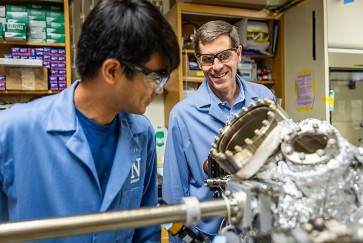
Mark Hersam elected to National Academy of Engineering
Innovative membrane platform enables analysis ‘down to a handful of gas atoms’, decorated nanoparticles prevent allergic reactions.
Argonne National Laboratory
Fixing spinal cord injuries with ‘ dancing molecules’.
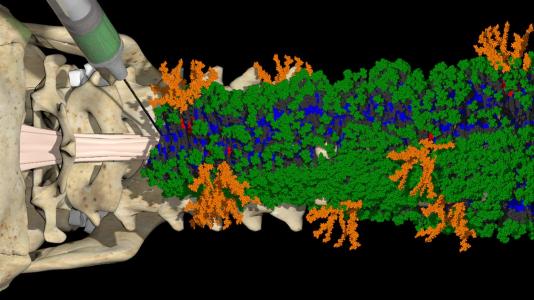
For decades, scientists have looked for an effective treatment for spinal cord injuries, often with little success. Now, new research by Northwestern University scientists has resulted in a game-changing innovation: an injection that uses “ dancing molecules” to repair spinal tissue and reverse paralysis.
The treatment has already been shown to work in mice. Paralyzed mice regained their ability to walk four weeks after an injection of the new treatment. The research, recently published in the journal, Science , offers hope to thousands of people who are paralyzed with severe spinal cord injuries every year.
“ This research will have broad impacts for biomedical therapies, not just for spinal cord injuries, but for other neurogenerative diseases that impact the nervous system, such as Alzheimer’s or strokes.” — Samuel Stupp, Northwestern University
“ Our research aims to find a therapy that can prevent individuals from becoming paralyzed after major trauma or disease,” said Samuel Stupp, a professor of materials science and engineering, chemistry, medicine and biomedical engineering at Northwestern who led the study. “ This has remained a major challenge for scientists because our body’s central nervous system, which includes the brain and spinal cord, does not have any significant capacity to repair itself after injury or after the onset of a degenerative disease.”

A critical portion of this research was conducted at the Advanced Photon Source ( APS ), a U.S. Department of Energy ( DOE ) Office of Science user facility at DOE ’s Argonne National Laboratory. There, scientists used ultrabright X-ray beams to study the structure of the engineered molecules and how they behaved together in a solution.
Injected as a liquid, the molecules came together in a solution to form tiny fiber structures (called nanofibers) that surrounded the spinal cord. The researchers discovered that the motion of molecules within the nanofibers could be controlled by changing their chemical structure. It turned out that molecules that moved most — “ danced” more — were more likely to signal cells via proteins called receptors, resulting in a more effective treatment.
“ Receptors in neurons and other cells constantly move around,” Stupp said. “ The key innovation in our research, which has never been done before, is to control the collective motion of more than 100,000 molecules within our nanofibers. By making the molecules move by design, translate, or even leap temporarily out of these structures, they are able to connect more effectively with receptors.”
Knowing the structure of the molecular matrix allowed Stupp to tune the motion of the molecules. By making the molecules “ dance,” they were more likely to find and engage cellular receptors, triggering the cells to repair damaged neurons.
Work to determine the organizational structure of the dancing molecules in their molecular assembly was done at the Dow Northwestern DuPont Collaborative Access Team ( DND-CAT ) beamline at the APS , run by Northwestern’s Synchrotron Research Center.
“ The APS is an important tool for this type of research,” said Northwestern’s Steven Weigand, a beamline scientist at DND-CAT and an author on the paper. At this experiment station, Northwestern researchers like Stupp can look at the structure of a variety of chemistries and make this a regular part of their experimental method. This station also allows scientists to look at molecules over a broad range of scales simultaneously, from hundreds of nanometers down to fewer than 10. (For scale, a sheet of paper is about 100,000 nanometers thick.)
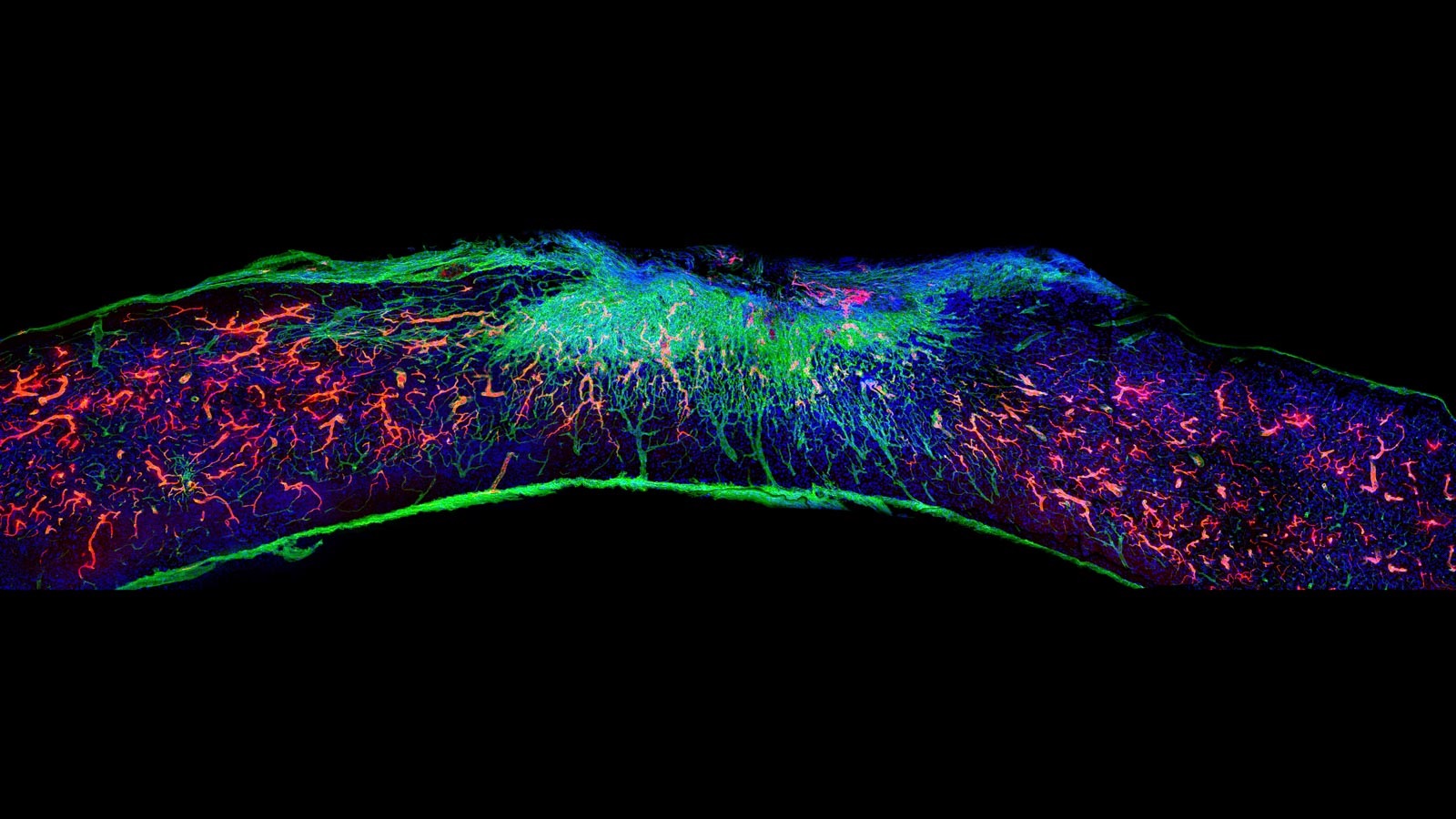
“ Without having ready access to the APS , you would have to be more restrictive on what samples you could run, and you may miss what’s important,” Weigand said.
X-ray experiments were a critical step in this discovery, Stupp said, adding that he could not have conducted key parts of this research without access to a light source facility such as the APS .
“ This research will have broad impacts for biomedical therapies, not just for spinal cord injuries, but for other neurogenerative diseases that impact the nervous system, such as Alzheimer’s or strokes,” he said.
Stupp is already in the process of applying for FDA approval to test the therapy in human subjects who have few other treatment options. He also has high hopes for using “ dancing molecules” to develop effective therapies for other diseases in the future.
For more on this story, read the Northwestern University press release .
About the Advanced Photon Source
The U. S. Department of Energy Office of Science’s Advanced Photon Source ( APS ) at Argonne National Laboratory is one of the world’s most productive X-ray light source facilities. The APS provides high-brightness X-ray beams to a diverse community of researchers in materials science, chemistry, condensed matter physics, the life and environmental sciences, and applied research. These X-rays are ideally suited for explorations of materials and biological structures; elemental distribution; chemical, magnetic, electronic states; and a wide range of technologically important engineering systems from batteries to fuel injector sprays, all of which are the foundations of our nation’s economic, technological, and physical well-being. Each year, more than 5,000 researchers use the APS to produce over 2,000 publications detailing impactful discoveries, and solve more vital biological protein structures than users of any other X-ray light source research facility. APS scientists and engineers innovate technology that is at the heart of advancing accelerator and light-source operations. This includes the insertion devices that produce extreme-brightness X-rays prized by researchers, lenses that focus the X-rays down to a few nanometers, instrumentation that maximizes the way the X-rays interact with samples being studied, and software that gathers and manages the massive quantity of data resulting from discovery research at the APS .
This research used resources of the Advanced Photon Source, a U.S. DOE Office of Science User Facility operated for the DOE Office of Science by Argonne National Laboratory under Contract No. DE-AC02-06CH11357 .
Argonne National Laboratory seeks solutions to pressing national problems in science and technology. The nation’s first national laboratory, Argonne conducts leading-edge basic and applied scientific research in virtually every scientific discipline. Argonne researchers work closely with researchers from hundreds of companies, universities, and federal, state and municipal agencies to help them solve their specific problems, advance America’s scientific leadership and prepare the nation for a better future. With employees from more than 60 nations, Argonne is managed by UChicago Argonne, LLC for the U.S. Department of Energy’s Office of Science .
The U.S. Department of Energy’s Office of Science is the single largest supporter of basic research in the physical sciences in the United States and is working to address some of the most pressing challenges of our time. For more information, visit https://energy.gov/science .
- ACS Foundation
- Diversity, Equity, and Inclusion
- ACS Archives
- Careers at ACS
- Federal Legislation
- State Legislation
- Regulatory Issues
- Get Involved
- SurgeonsPAC
- About ACS Quality Programs
- Accreditation & Verification Programs
- Data & Registries
- Standards & Staging
- Membership & Community
- Practice Management
- Professional Growth
- News & Publications
- Information for Patients and Family
- Preparing for Your Surgery
- Recovering from Your Surgery
- Jobs for Surgeons
- Become a Member
- Media Center
Our top priority is providing value to members. Your Member Services team is here to ensure you maximize your ACS member benefits, participate in College activities, and engage with your ACS colleagues. It's all here.
- Membership Benefits
- Find a Surgeon
- Find a Hospital or Facility
- Quality Programs
- Education Programs
- Member Benefits
- May 31, 2022 Issue
- Clinical Trials Show Promi...
Clinical Trials Show Promising Future for Management of Spinal Cord Injuries
May 31, 2022
By Glenn A. Gonzalez, MD, and James Harrop MD, MSQHS, FACS, Chair, ACS Advisory Council for Neurological Surgery
Spinal cord injury (SCI) is a significant source of global healthcare costs and morbidity. According to the National Spinal Cord Injury Statistics Center (NSCISC), the annual incidence of SCI is approximately 54 cases per 1 million people in the US, or approximately 17,700 new SCI cases per year. SCI can have a sudden and sometimes catastrophic impact on quality of life, resulting in severe motor, sensory, and autonomic dysfunction .
A collaborative effort has been made in recent years to develop new therapies that improve recovery for SCI patients. These therapies are intended to address the limited recovery capacity evidenced in the central nervous system. It has been essential to standardize the management and treatment of this condition. The use of the American Spinal Injury Association (ASIA) Impairment Scale has been well accepted for the evaluation of the functional impairment each patient presents.
"Time is brain" is a phrase most often used when discussing the management of acute ischemic stroke. However, in recent years, multiple studies have shown that "time is spine" because of the effectiveness of early management of SCI patients and attenuation of the damage produced from secondary activation of inflammatory cascades.
A study in the British Medical Journal , “Early versus Delayed Decompression for Traumatic Cervical Spinal Cord Injury: Results of the Surgical Timing in Acute Spinal Cord Injury Study (STASCIS)," changed the care algorithm for SCI patients. This study noted neurologic improvements are dependent on the timing of surgery. Further, it illustrated the most neurologically injured group, the ASIA A population, benefited most from early intervention.
In recent years, cell therapy, biomaterials, and electrical stimulation have become common, and it appeared these adjuvant treatments did improve neurological conditions. Multiple clinical trials are in the advanced phase—many with promising results. This article summarized some of the ongoing clinical trials and adjuvant treatments under investigation.
SCING-Spinal Cord Injury Neuroprotection with Glyburide
The SCING was an open-label, multicenter, prospective study authored by Amy Minnema and colleagues which studied the efficacy of oral glyburide in patients with acute traumatic spinal cord injury. This drug acts on the Sur1-transient receptor potential melastatin 4 (Trpm4) in the central nervous system, which is exclusively expressed in ischemia, hypoxia, and trauma and leads to vasogenic edema and cell death. Glyburide blocks the Sur1-Trpm4 channels and reduces complications and improves outcomes.
Role of Hepatocyte Growth Factor in the Treatment of Spinal Cord Injury
As part of its Phase I/II Study, Kringle Pharma, Inc., published a paper in 2020 that showed promising use of intrathecal administration recombinant human hepatocyte growth factor (KP-100) for acute SCI. Researchers analyzed the use of intrathecal KP-100 administration for SCI patients. In patients with a Frankel Grade A scale, lower extremities motor scores improved under KP-100. A more extensive phase III trial is necessary to assess the efficacy.
Granulocyte Colony Stimulating Factor (G-CSF) Granulocyte colony stimulating factor is a glycoprotein that has proven to have a protective effect on the spinal cord after acute spinal injury—mainly because it reduces the cellular damage caused by ischemia and halts the influence cytokines exert. Other studies showed that the mobilization of hematopoietic cells modulates nerve cell repair after SCI.
A Phase I/IIa nonrandomized clinical trial that Hiroshi Takahashi, MD, PhD, and colleagues performed in patients with acute (≤48 h) cervical and thoracic SCI for 5 days following injury did not show any side effects. Results seen after 3 months were superior to the use of high-dose methylprednisolone.
Cell-Based Therapies
Cell-based therapies for the treatment of SCI also are being explored. Treatment's potential pathogenesis includes modulating the inflammatory response, supplying trophic support, axon remyelination, and neuronal regeneration. Multiple primary therapies are on their way.
- Schwann cells (SCs) typically produce myelin and support the axons of the peripheral nervous system.
- Olfactory ensheathing cells are specialized glial cells located in both CNS and PNS. Because of their unique location, they have properties similar to astrocytes and SCs.
Biomaterials: Spinal Scaffolds The use of scaffolds to direct axonal regrowth is under investigation. Animal models have demonstrated that the use of these biomaterials improves axonal regeneration and results in enhanced motor recovery. Several clinical trials have been conducted with promising results.
Physiological Approaches
To date, numerous studies have shown that the control of physiological parameters improves the clinical results in patients with spinal cord injury. These parameters include acute intermittent hypoxia, cerebrospinal fluid drainage, and therapeutic hypothermia. In an animal study by Martirosyan and colleagues, spinal cord perfusion increased with the combination of heightened mean arterial pressure and cerebrospinal fluid drainage.
Functional Interventions
Locomotor training is a new concept based on the principle that increased neuromuscular activity can modify brain plasticity by increasing neuromuscular activity. This activation can achieve spinal cord stimulation intrinsically via task-specific sensory signals or extrinsically through stimulation. However, one limitation that has been evident in clinical trials is the absence of control groups and the variation in the methodology used in these studies.
Considerable progress in the treatment of spinal cord injury has been made in recent decades. The most important finding was that SCI is not a static disease, and multimodal treatment is necessary for better results. Although much work remains to be done in this field, the future is bright.
In This Issue: May 31, 2022
Current literature.
Commentaries summarizing important new scientific literature pertinent to surgeons and care teams.

Dr. Turner Offers Perspective on ACS Motto, ‘To Heal All with Skill and Trust’
Watch ACS Executive Director Patricia L. Turner, MD, MBA, FACS, detail the meanings of the College’s motto, “To Heal All with Skill and Trust.”

ACS Well-Being Resources Help Surgeons Navigate Challenging Times
As Mental Health Awareness Month draws to a close, review ACS Surgeon Well-Being resources to keep your mental health a priority.
Apply for the ACS Gerald B. Healy, MD, FACS, Traveling Mentorship Fellowship
Mentorship is a hallmark of academic and professional success, and the Dr. Healy Fellowship can help you achieve your goals.

ACS Members Can Watch 2022 ACS Leadership Summit Content for FREE and Earn CME
ACS members are invited to watch the 2022 Leadership Summit and collect CME - all for free.

Apply to Join ACS Committee on Diversity Issues to Address Healthcare Disparities
Join the committee and be a part of improving health disparities for surgery patients.

Register for Free ACS Well-Being Program Webinar on Caring for Patients, Loved Ones, and Yourself
Participate in this webinar to learn strategies for acting as a caretaker as you stay on top of your surgery career.

ACS Hosts In-Person and On-Demand General Surgery CPT Coding Workshops
ACS General Surgery Coding Workshops will keep you and your team up to date on the latest coding changes.
New Career Opportunities: Week of May 31, 2022
New career opportunities for May 2022, 2022.

Drs. Hoyt, Darling, Drake, Stewart, and Eight Others Headline This Year’s Clinical Congress Named Lectures
Influential individuals in surgery and healthcare will share their invaluable perspectives on a range of topics during Clinical Congress 2022.
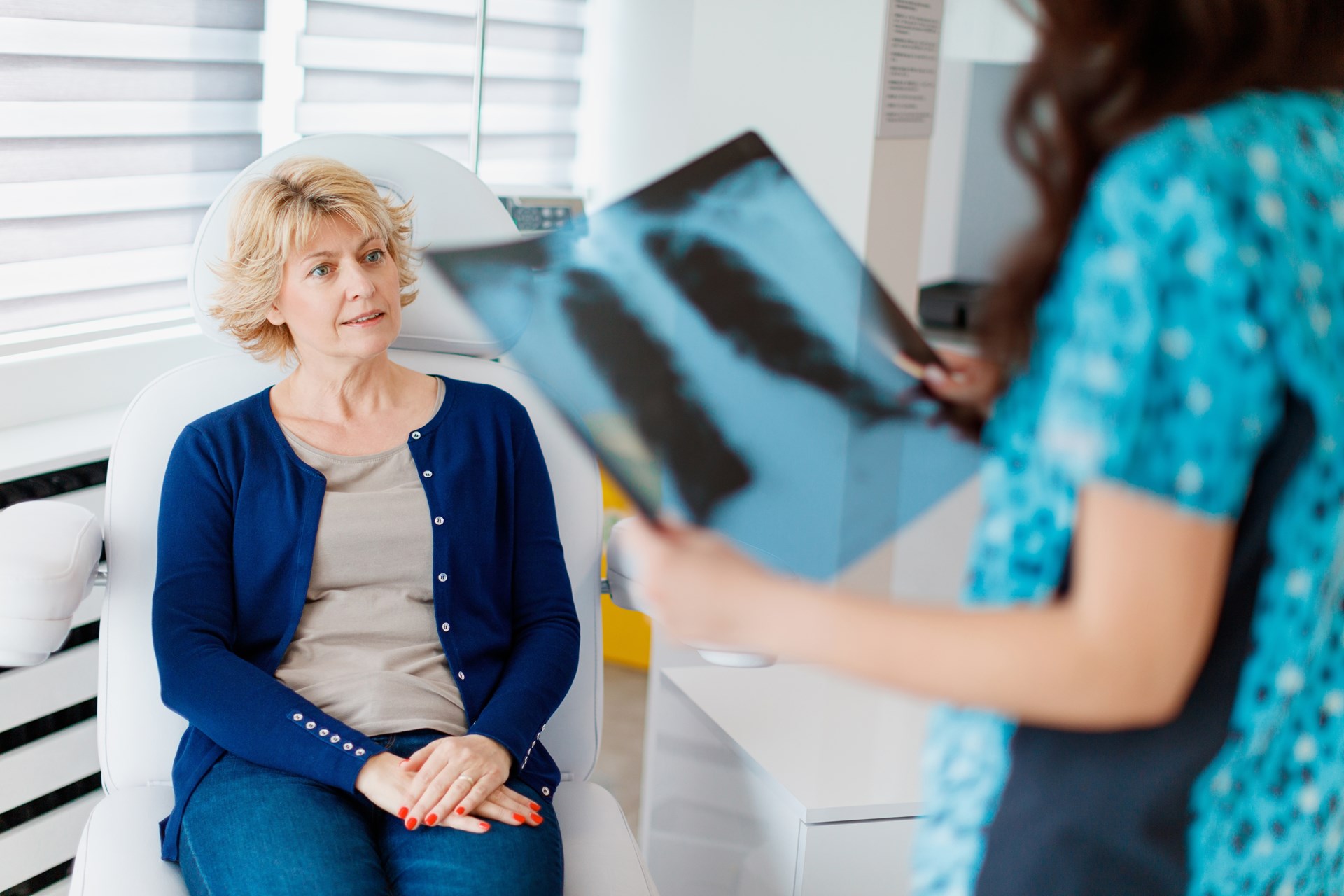
Long-COVID Research Indicates Implications for Surgery
Research into long COVID is coming into focus, and the findings may affect surgical decision-making.
Search form
Yale scientists repair injured spinal cords using patients’ own stem cells.

(© stock.adobe.com)
Intravenous injection of bone marrow derived stem cells (MSCs) in patients with spinal cord injuries led to significant improvement in motor functions, researchers from Yale University and Japan report Feb. 18 in the Journal of Clinical Neurology and Neurosurgery.
For more than half of the patients, substantial improvements in key functions — such as ability to walk, or to use their hands — were observed within weeks of stem cell injection, the researchers report. No substantial side effects were reported.
The patients had sustained non-penetrating spinal cord injuries, in many cases from falls or minor trauma, several weeks prior to implantation of the stem cells. Their symptoms involved loss of motor function and coordination, sensory loss, as well as bowel and bladder dysfunction. The stem cells were prepared from the patients’ own bone marrow, via a culture protocol that took a few weeks in a specialized cell processing center. The cells were injected intravenously in this series, with each patient serving as their own control. Results were not blinded and there were no placebo controls.
Yale scientists Jeffery D. Kocsis , professor of neurology and neuroscience, and Stephen G. Waxman , professor of neurology, neuroscience and pharmacology, were senior authors of the study, which was carried out with investigators at Sapporo Medical University in Japan. Key investigators of the Sapporo team, Osamu Honmou and Masanori Sasaki, both hold adjunct professor positions in neurology at Yale.
Kocsis and Waxman stress that additional studies will be needed to confirm the results of this preliminary, unblinded trial. They also stress that this could take years. Despite the challenges, they remain optimistic.
“ Similar results with stem cells in patients with stroke increases our confidence that this approach may be clinically useful,” noted Kocsis. “This clinical study is the culmination of extensive preclinical laboratory work using MSCs between Yale and Sapporo colleagues over many years.”
“ The idea that we may be able to restore function after injury to the brain and spinal cord using the patient’s own stem cells has intrigued us for years,” Waxman said. “Now we have a hint, in humans, that it may be possible.”
Health & Medicine

Advanced microscopy technique offers a new look inside cells

FAS professor theorizes ‘afterliveness’ in the digital age

U.S. Surgeon General Dr. Vivek Murthy to give Class Day address

Key to harnessing light waves? First do the math
- Show More Articles

- April 8, 2024 | Neutrinos Whisper Quantum Gravity Secrets From the South Pole
- April 8, 2024 | Teenage E-Cigarette Use Linked to Frequent Headaches
- April 8, 2024 | The Moon’s Great Inversion: How It Turned Itself Inside Out
- April 8, 2024 | What Came First the Chicken or the Egg? Discovery of Ancient Eggshells Rewrites Chicken History
- April 8, 2024 | Revolutionizing AI With the Power of Energy Efficiency
Spinal Cord Injury Breakthrough: Unique New Material Shows Great Potential
By University of Limerick February 9, 2023
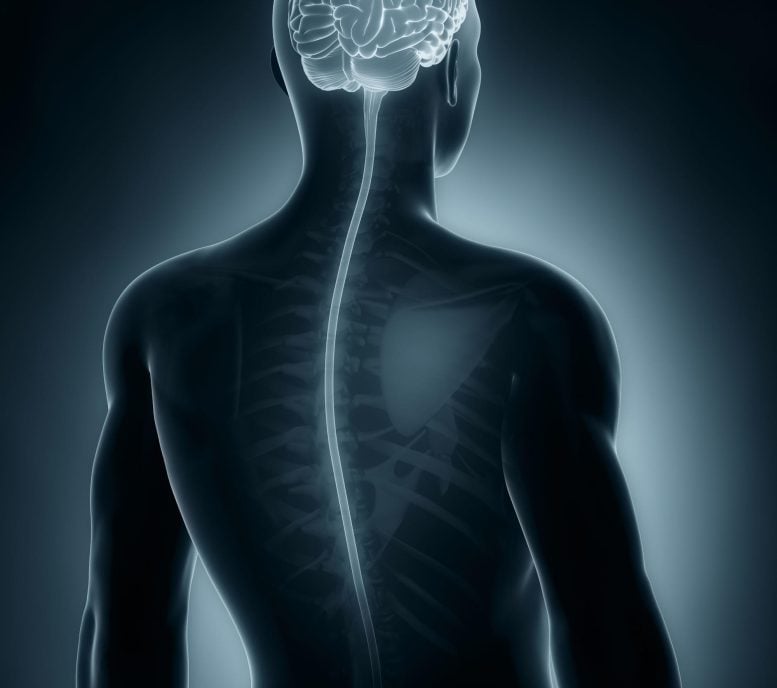
Spinal cord injuries are a serious and debilitating condition that occurs when there is damage to the spinal cord, which can result from a traumatic injury, such as a car accident, fall, or sports injury, or from a non-traumatic cause, such as infection, inflammation, or a tumor. The severity of a spinal cord injury depends on the location and extent of the damage. Injuries can range from a minor bruise or contusion, to a complete spinal cord transection, which can result in permanent paralysis of the affected limbs.
A hybrid biomaterial that has been successfully synthesized could be utilized to treat spinal injuries.
A unique material developed at the University of Limerick in Ireland has demonstrated considerable potential in the treatment of spinal cord injuries.
Exciting new research conducted at the Bernal Institute at the University of Limerick (UL) and published in the journal Biomaterials Research , has made significant strides in the area of spinal cord tissue repair.
New hybrid biomaterials developed at UL in the form of nanoparticles and building on existing practice in the tissue engineering field, were successfully synthesized to promote repair and regeneration following spinal cord injury, according to the researchers.
The UL team led by Professor Maurice N Collins, Associate Professor, School of Engineering at UL, and lead author Aleksandra Serafin, a Ph.D. candidate at UL, used a new kind of scaffolding material and a unique new electrically conducting polymer composite to promote new tissue growth and generation that could advance the treatment of spinal cord injury.
“Spinal Cord Injury remains one of the most debilitating traumatic injuries a person can sustain during their lifetime, affecting every aspect of the person’s life,” explained Professor Collins.
“The debilitating disorder results in paralysis below the level of injury and, in the US alone, the annual healthcare costs for SCI patient care are $9.7 billion. As there is currently no widely available treatment, continuous research into this field is crucial to find a treatment to improve the patient’s quality of life, with the research field turning towards tissue engineering for novel treatment strategies.
“The field of tissue engineering aims to solve the global problem of shortages of donated organs and tissues, in which a new trend has emerged in the form of conductive biomaterials. Cells in the body are affected by electrical stimulation, especially cells of a conductive nature such as cardiac or nerve cells,” Professor Collins explained.
The research team describes a growing interest in the use of electroconductive tissue-engineered scaffolds that have emerged due to the improved cell growth and proliferation when cells are exposed to a conductive scaffold.
“Raising the conductivity of biomaterials to develop such treatment strategies typically centers on the addition of conductive components such as carbon nanotubes or conductive polymers such as PEDOT:PSS, which is a commercially available conductive polymer that has been used to date in the tissue engineering field,” explained lead author Aleksandra Serafin, a Ph.D. candidate in the Bernal and at UL’s Faculty of Science and Engineering.
“Unfortunately, severe limitations persist when using the PEDOT:PSS polymer in biomedical applications. The polymer relies on the PSS component to allow it to be water soluble, but when this material is implanted in the body, it displays poor biocompatibility.
“This means that upon exposure to this polymer, the body has potential toxic or immunological responses, which are not ideal in an already damaged tissue which we are trying to regenerate. This severely limits which hydrogel components can be successfully incorporated to create conductive scaffolds,” she added.
Novel PEDOT nanoparticles (NPs) were developed in the study to overcome this limitation. Synthesis of conductive PEDOT NPs allows for the tailored modification of the surface of the NPs to achieve desired cell response and increase the variability of which hydrogel components can be incorporated, without the required presence of PSS for water solubility.
In this work, hybrid biomaterials comprised of gelatin and immunomodulatory hyaluronic acid , a material that Professor Collins has developed over many years at UL, were combined with the developed novel PEDOT NPs to create biocompatible electroconductive scaffolds for targeted spinal cord injury repair.
A complete study of the structure, property, and function relationships of these precisely designed scaffolds for optimized performance at the site of injury was carried out, including in-vivo research with rat spinal cord injury models, which was undertaken by Ms. Serafin during a Fulbright research exchange to the University of California San Diego Neuroscience Department, who was a partner on the project.
“The introduction of the PEDOT NPs into the biomaterial increased the conductivity of samples. In addition, the mechanical properties of implanted materials should mimic the tissue of interest in tissue-engineered strategies, with the developed PEDOT NP scaffolds matching the mechanical values of the native spinal cord,” explained the researchers.
Biological responses to the developed PEDOT NP scaffolds were studied with stem cells in-vitro and in animal models of spinal cord injury in-vivo. Excellent stem cell attachment and growth on the scaffolds were observed, they reported.
Testing showed greater axonal cell migration towards the site of spinal cord injury, into which the PEDOT NP scaffold was implanted, as well as lower levels of scarring and inflammation than in the injury model which had no scaffold, according to the study.
Overall, these results show the potential of these materials for spinal cord repair, says the research team.
‘’The impact that spinal cord injury has on a patient’s life is not only physical, but also psychological, since it can severely affect the patient’s mental health, resulting in increased incidences of depression, stress, or anxiety,” explained Ms. Serafin.
“Treating spinal injuries will therefore not only allow for the patient to walk or move again but will allow them to live their lives to their full potential, which makes projects such as this one so vital to the research and medical communities. In addition, the overall societal impact of providing an effective treatment for spinal cord injuries will lead to a reduction in healthcare costs associated with treating patients.
“These results offer encouraging prospects for patients and further research into this area is planned.
“Studies have shown that the excitability threshold of motor neurons on the distal end of a spinal cord injury tends to be higher. A future project will further improve the scaffold design and create conductivity gradients in the scaffold, with the conductivity increasing towards the distal end of the lesion to further stimulate neurons to regenerate,” she added.
Reference: “Electroconductive PEDOT nanoparticle integrated scaffolds for spinal cord tissue repair” by Aleksandra Serafin, Mario Culebras Rubio, Marta Carsi, Pilar Ortiz-Serna, Maria J. Sanchis, Atul K. Garg, J. Miguel Oliveira, Jacob Koffler and Maurice N. Collins, 22 November 2022, Biomaterials Research . DOI: 10.1186/s40824-022-00310-5
This project was funded by the Irish Research Council in partnership with Johnson & Johnson as well as the Irish Fulbright Association, which enabled a research exchange to the University of California San Diego. The faculty of Science and Engineering and the Health Research Institute at UL also provided support.
More on SciTechDaily
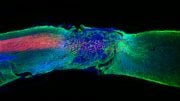
Regenerative Medicine Breakthrough: “Dancing Molecules” Successfully Repair Severe Spinal Cord Injuries
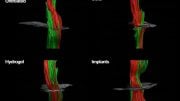
Human Spinal Cord Implants: Breakthrough May Enable People With Paralysis To Walk Again
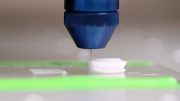
Biofabrication Method “Steals From Nature” for Regeneration of Multiple Tissues
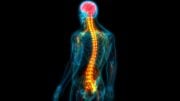
Research Shows Investigational Cancer Drug Can Boost Regeneration of Damaged Nerves After Spinal Cord Injury
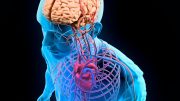
Challenging Established Beliefs: Harvard Research Uncovers Surprising New Roles for Spinal Cord and Brainstem
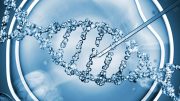
Epigenetic Treatment Can Help the Spinal Cord Regenerate After Injury
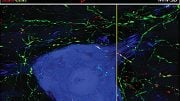
Study Shows Stem Cell Injections Improve Spinal Injuries in Rats
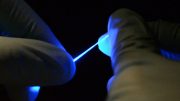
MIT Researchers Develop Multifunctional Fibers to Study Spinal Cord Neurons
4 comments on "spinal cord injury breakthrough: unique new material shows great potential".
Question, will this only help newly injured, or will it help people who have had spinal cord for injury 20, 30 and 40 years? I have a friend who has been a paraplegic since she was around 13 years old, she has so much to give, but being locked away in a nursing home that repeatedly neglects and injures her, and that has become her prison is not acceptable.
This article actually gave me hope, for others, as I have rarely been so at my age, & psychologically stressed enough from my disability caused by a blood transfusion for an RH factor. It is “thought” that the transfusion was performed via an umbilical artery instead of a vein, then clotted; blocking nutrients from the posterior of my spine. When I was 14, Shriner’s in Chicago said I was the first in 30 years w such related “cause”.
This is so exciting and encouraging. I only pray that this new technology will not exclude me. I have waited for over 50 years for this news. I didn’t sit and wait, I raised two children on a ranch as well as worked in wonderful jobs for 25 years plus I entered the national wheelchair games in New York and received second place nationally in archery.
Please, I have a friend in Việt Nam that had a good IT job with Foxconn in Việt Nam. Last year he had a motorbike accident which caused a spinal cord injury. He lost the use of his legs. PLEASE I would love to know more about this procedure. My friend needs some good news. He lives with his parents now and tries to sell items in his hometown, it is really hard to live in Việt Nam. He would love to be able to participate in this research if possible. PLEASE let me know!! I need to know how to contact someone for more information. Thank you!!
Leave a comment Cancel reply
Email address is optional. If provided, your email will not be published or shared.
Save my name, email, and website in this browser for the next time I comment.
New orally available drug for spinal cord injury found to be safe and tolerable in healthy participants
New research from the Institute of Psychiatry, Psychology & Neuroscience (IoPPN) at King's College London has demonstrated the safety and tolerability of a new drug treatment designed as a therapeutic intervention for spinal cord injury (SCI).
The research, published in British Journal of Clinical Pharmacology , found that the KCL-286 drug -- which works by activating retinoic acid receptor beta (RARb) in the spine to promote recovery -- was well tolerated by participants in a Phase 1 clinical trial, with no severe side effects. Researchers are now seeking funding for a Phase 2a trial studying the safety and tolerability of the drug in those with SCI.
Global prevalence of SCI is estimated to be between 0.7 and 1.2 million cases per year, with falls and road accidents being the major causes. Despite incurring a cost of $4 billion per year in direct healthcare and indirect costs (i.e. inability to work and social care) in the US alone, there are no licensed drugs that can tackle the intrinsic failure of the adult central nervous system to regenerate, and thus remains a largely unmet clinical need.
Previous research by various groups has shown that nerve growth can be stimulated by activating the RARb2 receptor, but no drug suitable for humans has been developed. KCL-286, an RARb2 agonist 1 , was developed by Professor Corcoran and team and used in a first in man study to test its safety in humans.
109 healthy males were divided into one of two trial groups; single ascending dose (SAD) adaptive design with a food interaction (FI) arm, and multiple ascending dose (MAD) arm. Participants in each arm were further divided into different dose treatments.
SAD studies are designed to establish the safe dosage range of a medicine by providing participants with small doses before gradually increasing the dose provided. Researchers look for any side effects, and measure how the medicine is processed within the body. MAD studies explore how the body interacts with repeated administration of the drug, and investigate the potential for a drug to accumulate within the body.
Researchers found that participants were able to safely take 100mg doses of KCL-286, with no severe adverse events.
Professor Jonathan Corcoran, Professor of Neuroscience and Director of the Neuroscience Drug Discovery Unit, at King's IoPPN and the study's senior author said, "This represents an important first step in demonstrating the viability of KCL-286 in treating spinal cord injuries. This first-in-human study has shown that a 100mg dose delivered via a pill can be safely taken by humans. Furthermore, we have also shown evidence that it engages with the correct receptor.
"Our focus can hopefully now turn to researching the effects of this intervention in people with spinal cord injuries."
Dr. Bia Goncalves, a senior scientist and project manager of the study, and the study's first author from King's IoPPN said, "Spinal Cord Injuries are a life changing condition that can have a huge impact on a person's ability to carry out the most basic of tasks, and the knock-on effects on their physical and mental health are significant.
"The outcomes of this study demonstrate the potential for therapeutic interventions for SCI, and I am hopeful for what our future research will find."
This work was possible thanks to funding from the Medical Research Council.
- Pharmacology
- Bone and Spine
- Today's Healthcare
- Neuroscience
- Illegal Drugs
- Spinal cord
- Pharmaceutical company
- Central nervous system
- Drug discovery
- Sympathetic nervous system
- Spinal muscular atrophy
- Embryonic stem cell
Story Source:
Materials provided by King's College London . Note: Content may be edited for style and length.
Journal Reference :
- Maria B. Goncalves, Tim Mant, Jörg Täubel, Earl Clarke, Hana Hassanin, Daryl Bendel, Henry Fok, John Posner, Jane Holmes, Adrian P. Mander, Jonathan P. T. Corcoran. Phase 1 safety, tolerability, pharmacokinetics and pharmacodynamic results of KCL‐286, a novel retinoic acid receptor‐β agonist for treatment of spinal cord injury, in male healthy participants . British Journal of Clinical Pharmacology , 2023; DOI: 10.1111/bcp.15854
Cite This Page :
Explore More
- Pregnancy Accelerates Biological Aging
- Tiny Plastic Particles Are Found Everywhere
- What's Quieter Than a Fish? A School of Them
- Do Odd Bones Belong to Gigantic Ichthyosaurs?
- Big-Eyed Marine Worm: Secret Language?
- Unprecedented Behavior from Nearby Magnetar
- Soft, Flexible 'Skeletons' for 'Muscular' Robots
- Toothed Whale Echolocation and Jaw Muscles
- Friendly Pat On the Back: Free Throws
- How the Moon Turned Itself Inside Out
Trending Topics
Strange & offbeat.
Engineering | Health and medicine | News releases | Research | Science | Soundbites | Technology | Video
January 12, 2021
New treatment allows some people with spinal cord injury to regain hand and arm function
Note: This video was created in January 2020
Almost 18,000 Americans experience traumatic spinal cord injuries every year. Many of these people are unable to use their hands and arms and can’t do everyday tasks such as eating, grooming or drinking water without help.
For journalists
Download video, B-roll and photos
Using physical therapy combined with a noninvasive method of stimulating nerve cells in the spinal cord, University of Washington researchers helped six Seattle area participants regain some hand and arm mobility. That increased mobility lasted at least three to six months after treatment had ended. The research team published these findings Jan. 5 in the journal IEEE Transactions on Neural Systems and Rehabilitation Engineering.
“We use our hands for everything — eating, brushing our teeth, buttoning a shirt. Spinal cord injury patients rate regaining hand function as the absolute first priority for treatment. It is five to six times more important than anything else that they ask for help on,” said lead author Dr. Fatma Inanici , a UW senior postdoctoral researcher in electrical and computer engineering who completed this research as a doctoral student of rehabilitation medicine in the UW School of Medicine.
“At the beginning of our study,” Inanici said, “I didn’t expect such an immediate response starting from the very first stimulation session. As a rehabilitation physician, my experience was that there was always a limit to how much people would recover. But now it looks like that’s changing. It’s so rewarding to see these results.”

Fatma Inanici applies small patches that will deliver electrical currents to the injured area on a participant’s neck. Note: This photo was taken in 2018. Marcus Donner/Center for Neurotechnology
After a spinal cord injury, many patients do physical therapy to help them attempt to regain mobility. Recently, a series of studies have shown that implanting a stimulator to deliver electric current to a damaged spinal cord could help paralyzed patients walk again.
The UW team, composed of researchers from the Center for Neurotechnology , combined stimulation with standard physical therapy exercises, but the stimulation doesn’t require surgery. Instead, it involves small patches that stick to a participant’s skin like a Band-Aid. These patches are placed around the injured area on the back of the neck where they deliver electrical pulses.
The researchers recruited six people with chronic spinal cord injuries. All participants had been injured for at least a year and a half. Some participants couldn’t wiggle their fingers or thumbs while others had some mobility at the beginning of the study.
To explore the viability of using the skin-surface stimulation method, the researchers designed a five-month training program. For the first month, the researchers monitored participants’ baseline limb movements each week. Then for the second month, the team put participants through intensive physical therapy training, three times a week for two hours at a time. For the third month, participants continued physical therapy training but with stimulation added.
“We turned on the device, but they continued doing the exact same exercises they did the previous month, progressing to slightly more difficult versions if they improved,” Inanici said.

Participants progressed to more difficult versions of the training exercises (for example, going from picking up a ping pong ball to picking up a tiny bead, shown here) as they improved. Note: This photo was taken in 2019. Marcus Donner/Center for Neurotechnology
For the last two months of the study, participants were divided into two categories: Participants with less severe injuries received another month of training alone and then a month of training plus stimulation. Patients with more severe injuries received the opposite — training and stimulation first, followed by only training second.

The researchers designed a five-month training program that included month-long regimens of training alone or training with stimulation. Inanici et. al, IEEE Transactions on Neural Systems and Rehabilitation Engineering
While some participants regained some hand function during training alone, all six saw improvements when stimulation was combined with training.
“Both people who had no hand movement at the beginning of the study started moving their hands again during stimulation, and were able to produce a measurable force between their fingers and thumb,” said senior author Chet Moritz , a UW associate professor of electrical and computer engineering, rehabilitation medicine and physiology and biophysics. “That’s a dramatic change, to go from being completely paralyzed below the wrists down to moving your hands at will.”
In addition, some participants noticed other improvements, including a more normal heart rate and better regulation of body temperature and bladder function.
The team followed up with participants for up to six months after training and found that these improvements remained, despite no more stimulation.
“We think these stimulators bring the nerves that make your muscles contract very close to being active. They don’t actually cause the muscle to move, but they get it ready to move. It’s primed, like the sprinter at the start of a race,” said Moritz, who is also the co-director of the Center for Neurotechnology. “Then when someone with a spinal cord injury wants to move, the few connections that might have been spared around the injury are enough to cause those muscles to contract.”

Chet Moritz (left) and Fatma Inanici (center) observe as a participant (right) measures grip strength (by squeezing the device in his hand). The participant has sensors on his arms (black cases) to measure his arm muscle activity during the task. Note: This photo was taken in 2019. Marcus Donner/Center for Neurotechnology
The research is moving toward helping people in the clinic. The results of this study have already informed the design of an international multi-site clinical trial that will be co-led by Moritz. One of the lead sites will be at the UW.
“We’re seeing a common theme across universities — stimulating the spinal cord electrically is making people better,” said Moritz, who also holds the CJ and Elizabeth Hwang professorship in electrical and computer engineering. “But it does take motivation. The stimulator helps you do the exercises, and the exercises help you get stronger, but the improvements are incremental. Over time, however, they add up into something that’s really astounding.”
Lorie Brighton , a research scientist at the UW; Soshi Samejima , a UW doctoral student in rehabilitation medicine; and Dr. Christoph Hofstetter , an associate professor of neurological surgery in the UW School of Medicine, are co-authors on this paper. This research was funded by the Center for Neurotechnology, the Washington State Spinal Cord Injury Consortium and the Christopher and Dana Reeve Foundation.
For more information, contact Inanici at [email protected] and Moritz at [email protected] .
Grant number: EEC-1028725
News releases
Read more news releases
Search UW News
Artificial intelligence, flooding and landslides, latest news releases.

20 hours ago

UW Today Newsletter
UW Today Daily
UW Today Week in Review
For UW employees
Be boundless, connect with us:.
© 2024 University of Washington | Seattle, WA
- Alzheimer's disease & dementia
- Arthritis & Rheumatism
- Attention deficit disorders
- Autism spectrum disorders
- Biomedical technology
- Diseases, Conditions, Syndromes
- Endocrinology & Metabolism
- Gastroenterology
- Gerontology & Geriatrics
- Health informatics
- Inflammatory disorders
- Medical economics
- Medical research
- Medications
- Neuroscience
- Obstetrics & gynaecology
- Oncology & Cancer
- Ophthalmology
- Overweight & Obesity
- Parkinson's & Movement disorders
- Psychology & Psychiatry
- Radiology & Imaging
- Sleep disorders
- Sports medicine & Kinesiology
- Vaccination
- Breast cancer
- Cardiovascular disease
- Chronic obstructive pulmonary disease
- Colon cancer
- Coronary artery disease
- Heart attack
- Heart disease
- High blood pressure
- Kidney disease
- Lung cancer
- Multiple sclerosis
- Myocardial infarction
- Ovarian cancer
- Post traumatic stress disorder
- Rheumatoid arthritis
- Schizophrenia
- Skin cancer
- Type 2 diabetes
- Full List »
share this!
April 19, 2023
This article has been reviewed according to Science X's editorial process and policies . Editors have highlighted the following attributes while ensuring the content's credibility:
fact-checked
peer-reviewed publication
trusted source
New neurological target to help people walk again after a spinal cord injury
by Laval University
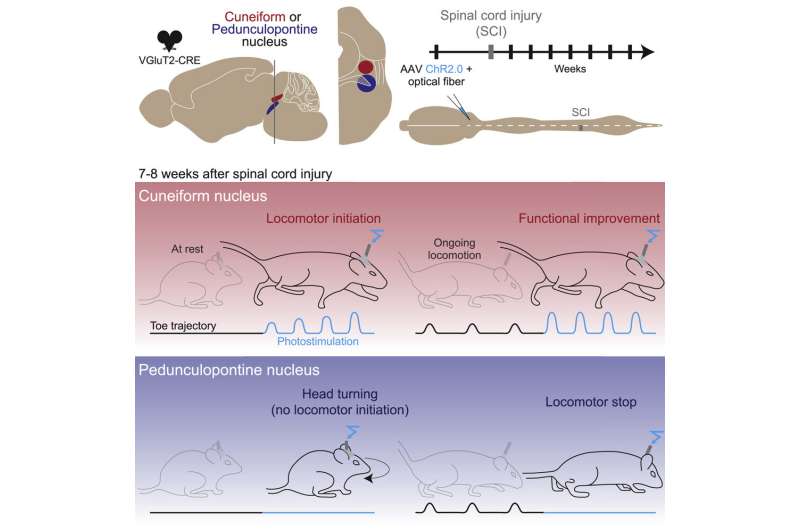
People who have lost control of their legs following a spinal cord injury may walk again someday. A research team affiliated with Université Laval and the CHU de Québec-Université Laval Research Center has pinpointed a new neurological target that could improve the recovery of gait.
Contrary to popular belief, spinal cord injuries are rarely complete. The brain retains access to the spinal cord circuitry below the lesion, but this connection is often dormant. Deep brain stimulation, or electrical stimulation , could activate it and promote recovery of locomotion. But which area of the brain should be targeted?
A research team led by Frédéric Bretzner, a professor at a professor at Université Laval's Faculty of Medicine, has focused on a locomotor center of the brain known as the mesencephalic locomotor region.
This area is known as a trigger and accelerator for walking in several animal species. It is composed of the cuneiform nucleus and the pedunculopontine nucleus. Deep brain stimulation of the pedunculopontine nucleus has generated ambiguous results in Parkinson's patients with gait and postural disorders. However, there are no clinical studies on the cuneiform nucleus.
A promising area of the brain
Professor Frédéric Bretzner's team used optogenetics to modify neurons to make them light-sensitive. The team then used blue light to activate glutamatergic, or excitatory, neurons in the cuneiform or pedunculopontine nucleus in mice.
"After spinal cord injury, stimulation in the cuneiform nucleus of excitatory neurons initiated walking in resting mice. During a spontaneous walking episode, stimulation also improved the quality of the mouse's walk and the coordination between the muscles of its hind legs," explains Frédéric Bretzner.
Conversely, the stimulation of glutamatergic neurons in the pedunculopontine nucleus rarely triggered walking in mice at rest. Stimulation even caused mice to stop when they walked.
"Our results suggest that the cuneiform nucleus would be a better neurological target than the pedunculopontine nucleus to improve walking recovery in people with a spinal cord injury," reports Professor Bretzner.
While waiting for the development of implants and optogenetic tools adapted to target glutamatergic neurons of the cuneiform nucleus in humans, electrical stimulation of the cuneiform nucleus could already improve walking recovery in patients with spinal cord injury.
This approach could also improve the quality of life of individuals suffering from traumas or neurodegenerative diseases affecting gait and posture, such as stroke, amyotrophic lateral sclerosis , or Parkinson's disease.
The findings are published in the journal Cell Reports Medicine .
Explore further
Feedback to editors

'Deaths of despair' among Black Americans surpassed those of white Americans in 2022
2 minutes ago

Industry gifts may influence which cardiac device is used in common lifesaving procedure

Researchers identify protein that controls CAR T cell longevity

Researchers explore role of androgens in shaping sex differences

Living near green space associated with fewer emotional problems in preschool-age kids, study finds

Serious flu damage prevented by compound that blocks unnecessary cell death

New mechanism discovered for life-threatening arrhythmias in Andersen-Tawil syndrome
3 minutes ago

Looking at the environment around tumors could help predict how cancer spreads
6 minutes ago

Researchers identify neurons responsible for key activity transition in brain development
9 minutes ago

Neuroscience study taps into brain network patterns to understand deep focus, attention
13 minutes ago
Related Stories

Midbrain 'start neurons' control whether we walk or run
Jan 17, 2018

Scientists identify neurons that restore walking after paralysis
Nov 10, 2022

Improving treatment for Parkinson's
Feb 18, 2022


Spinal cord injury: Can brain and nerve stimulation restore movement?
Jan 20, 2023

Key brain region involved in more than locomotion, finding may improve Parkinson's treatments
Jul 26, 2021

Researchers confirm brain region's role in mind-body communication
Jul 26, 2022
Recommended for you

Connecting lab-grown brain cells provides insight into how our own brains work
6 hours ago

Morphine tolerance found to result from Tiam1-mediated maladaptive plasticity in spinal neurons
18 hours ago

New atlas of mRNA variants captures inner workings of the brain
22 hours ago

New state of mind: Rethinking how researchers understand brain activity
Apr 9, 2024

Brain vesicles found to contain selectively packaged, full-length mRNA

New insights into cholesterol dynamics shed light on neurodegenerative disease
Let us know if there is a problem with our content.
Use this form if you have come across a typo, inaccuracy or would like to send an edit request for the content on this page. For general inquiries, please use our contact form . For general feedback, use the public comments section below (please adhere to guidelines ).
Please select the most appropriate category to facilitate processing of your request
Thank you for taking time to provide your feedback to the editors.
Your feedback is important to us. However, we do not guarantee individual replies due to the high volume of messages.
E-mail the story
Your email address is used only to let the recipient know who sent the email. Neither your address nor the recipient's address will be used for any other purpose. The information you enter will appear in your e-mail message and is not retained by Medical Xpress in any form.
Newsletter sign up
Get weekly and/or daily updates delivered to your inbox. You can unsubscribe at any time and we'll never share your details to third parties.
More information Privacy policy
Donate and enjoy an ad-free experience
We keep our content available to everyone. Consider supporting Science X's mission by getting a premium account.
E-mail newsletter
Paralyzed man who can walk again shows potential benefit of stem cell therapy
A Mayo Clinic study used a patient's stem cells to help repair the spinal cord.
A man who was paralyzed from the neck down after a surfing accident seven years ago is now able to stand and walk on his own , thanks in part to a potentially groundbreaking stem cell treatment.
Chris Barr was the very first patient in a Mayo Clinic study that collected stem cells from his own stomach fat, expanded them in a laboratory to 100 million cells and then injected the cells into Barr's lumbar spine.
Over five years after undergoing the therapy, Barr said he is continuing to gain more independence and get faster at walking.
"I never dreamed I would have a recovery like this," Barr told ABC News' Will Reeve. "I can feed myself. I can walk around. I can do day-to-day independent activities."
Barr shared an update with Reeve on his own progress as Mayo Clinic published new data showing the success of the stem cell treatment in a clinical trial involving 10 patients, including Barr.

According to the trial's results, published Monday in the journal Nature Communications , seven of the 10 patients experienced increased strength in muscle motor groups and increased sensation to pinpricks and light touch.
MORE: Artificial intelligence used in medical procedure to help paralyzed man walk
Three patients in the study had no response to the stem cell therapy, meaning they did not get better or worse, according to the Mayo Clinic, based in Rochester, Minnesota.
"These findings give us hope for the future," Dr. Mohamad Bydon, a neurosurgeon and spinal cord researcher at the Mayo Clinic and the study's lead author, told Reeve, who is also the director of The Christopher Reeve Foundation, a nonprofit "dedicated to curing spinal cord injury," according to its website. The foundation, named in honor of Will Reeve's late father, was not involved in the funding of Bydon's research.
Bydon's research at the Mayo Clinic is a Phase 1 study that began in 2018.
The newly published results of the study show that of the seven patients who saw improvement after the stem cell therapy, each moved up at least one level on the American Spinal Injury Association -- or ASIA -- Impairment Scale, which has five levels documenting patients' function.
"This trial shows us that stem cells are safe and potentially beneficial in the treatment of spinal cord injury," Bydon said. "This can be a milestone in our field of neurosurgery, neuroscience and of treating patients with spinal cord injury."
Related Stories

Missouri governor denies clemency for man scheduled for execution on Tuesday
- Apr 8, 11:16 AM

Multiple hurt in crash during dust storm
- Apr 1, 7:34 PM

Eclipse livestream: Watch total solar eclipse
- Apr 8, 12:40 PM
There is currently no U.S. Food and Drug Administration-approved treatment for spinal cord injury.
MORE: Man in wheelchair from paralysis walks again thanks to a new medical innovation
Bydon and other researchers are still trying to understand how and why the stem cells interact with the spinal cord to result in progress for some patients, and additional research is underway among a larger group of people to further assess risks and benefits.
In Barr's case, he told Reeve in 2019 he began to quickly see improvements, like getting feeling back in his legs, after undergoing the stem cell treatment.

Now five years later, he described making further long-term improvements, like being able to walk for consistent intervals without assistance.
"I'm just thrilled that there are people taking bold steps to try and do research to cure this," Barr said. "It's been a wild ride and it's not over yet."
Dr. Priscilla Koirala, a member of the ABC News Medical Unit, contributed to this report.

Body of 3rd Key Bridge victim recovered
- Apr 9, 10:48 AM

New York appeals judge rejects Donald Trump’s request to delay his April 15 hush money trial
- Apr 8, 2:07 PM
ABC News Live
24/7 coverage of breaking news and live events

An official website of the United States government
Here’s how you know
Official websites use .gov A .gov website belongs to an official government organization in the United States.
Secure .gov websites use HTTPS A lock ( Lock A locked padlock ) or https:// means you’ve safely connected to the .gov website. Share sensitive information only on official, secure websites.
https://www.nist.gov/news-events/news/2024/04/chips-america-and-natcast-give-update-national-semiconductor-technology
CHIPS for America and Natcast to Give Update on the National Semiconductor Technology Center

The CHIPS for America Research and Development (R&D) Program and Natcast , the operator of the CHIPS for America National Semiconductor Technology Center (NSTC), will host a webinar to provide an overview of the NSTC’s vision and mission, an update on 2024 priorities for the NSTC, the standing up of Natcast, and the first NSTC research opportunities.
The NSTC, the centerpiece of the CHIPS for America R&D Program, is a public-private consortium for industry, customers, suppliers, educational institutions, workforce and labor organizations, entrepreneurs, government, and investors to accelerate the pace of new innovations from idea to marketplace. To that end, the Biden-Harris Administration expects to invest over $5 billion in the NSTC with a core tenet of funding R&D projects that create long-term US leadership in semiconductor technology.
While the long-term R&D strategy is being crafted, the NSTC has identified initial R&D programs which will kick start the process of delivering impactful results through early investments in projects with a near term time horizon. At least $100 million will be available to fund the first set of external teams through competitions expected to launch in the summer of 2024. The projects will develop R&D tools and results that can be deployed into the semiconductor industry to drive advancements in critical technologies such as the use of Artificial Intelligence (AI) in design, and the enablement of researchers to produce results faster with lower cost, resulting in the acceleration of innovation and the time required to bring new products to market.
Join CHIPS NSTC Program Director, Jay Lewis, and Natcast Chief Executive Officer, Deirdre Hanford on April 9, 2024 , for a discussion on early research, the NSTC Community of Interest, and additional updates on this historic program. Registration is required.
This is the first of a series of monthly updates on the NSTC.
Read our research on: Gun Policy | International Conflict | Election 2024
Regions & Countries
Changing partisan coalitions in a politically divided nation, party identification among registered voters, 1994-2023.
Pew Research Center conducted this analysis to explore partisan identification among U.S. registered voters across major demographic groups and how voters’ partisan affiliation has shifted over time. It also explores the changing composition of voters overall and the partisan coalitions.
For this analysis, we used annual totals of data from Pew Research Center telephone surveys (1994-2018) and online surveys (2019-2023) among registered voters. All telephone survey data was adjusted to account for differences in how people respond to surveys on the telephone compared with online surveys (refer to Appendix A for details).
All online survey data is from the Center’s nationally representative American Trends Panel . The surveys were conducted in both English and Spanish. Each survey is weighted to be representative of the U.S. adult population by gender, age, education, race and ethnicity and other categories. Read more about the ATP’s methodology , as well as how Pew Research Center measures many of the demographic categories used in this report .
The contours of the 2024 political landscape are the result of long-standing patterns of partisanship, combined with the profound demographic changes that have reshaped the United States over the past three decades.
Many of the factors long associated with voters’ partisanship remain firmly in place. For decades, gender, race and ethnicity, and religious affiliation have been important dividing lines in politics. This continues to be the case today.
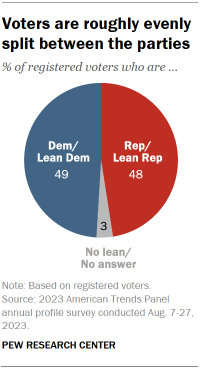
Yet there also have been profound changes – in some cases as a result of demographic change, in others because of dramatic shifts in the partisan allegiances of key groups.
The combined effects of change and continuity have left the country’s two major parties at virtual parity: About half of registered voters (49%) identify as Democrats or lean toward the Democratic Party, while 48% identify as Republicans or lean Republican.
In recent decades, neither party has had a sizable advantage, but the Democratic Party has lost the edge it maintained from 2017 to 2021. (Explore this further in Chapter 1 . )
Pew Research Center’s comprehensive analysis of party identification among registered voters – based on hundreds of thousands of interviews conducted over the past three decades – tracks the changes in the country and the parties since 1994. Among the major findings:
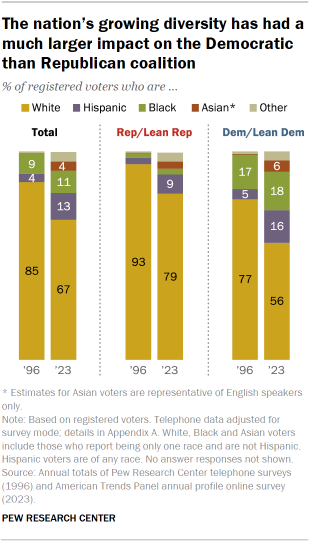
The partisan coalitions are increasingly different. Both parties are more racially and ethnically diverse than in the past. However, this has had a far greater impact on the composition of the Democratic Party than the Republican Party.
The share of voters who are Hispanic has roughly tripled since the mid-1990s; the share who are Asian has increased sixfold over the same period. Today, 44% of Democratic and Democratic-leaning voters are Hispanic, Black, Asian, another race or multiracial, compared with 20% of Republicans and Republican leaners. However, the Democratic Party’s advantages among Black and Hispanic voters, in particular, have narrowed somewhat in recent years. (Explore this further in Chapter 8 .)
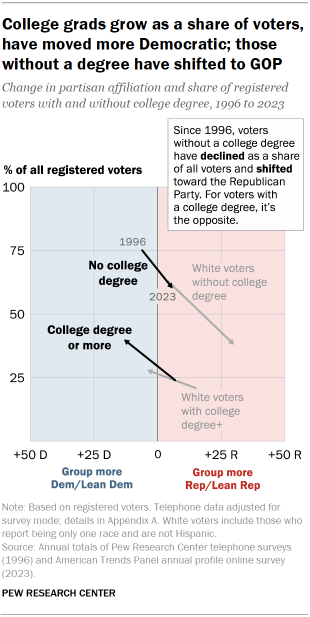
Education and partisanship: The share of voters with a four-year bachelor’s degree keeps increasing, reaching 40% in 2023. And the gap in partisanship between voters with and without a college degree continues to grow, especially among White voters. More than six-in-ten White voters who do not have a four-year degree (63%) associate with the Republican Party, which is up substantially over the past 15 years. White college graduates are closely divided; this was not the case in the 1990s and early 2000s, when they mostly aligned with the GOP. (Explore this further in Chapter 2 .)
Beyond the gender gap: By a modest margin, women voters continue to align with the Democratic Party (by 51% to 44%), while nearly the reverse is true among men (52% align with the Republican Party, 46% with the Democratic Party). The gender gap is about as wide among married men and women. The gap is wider among men and women who have never married; while both groups are majority Democratic, 37% of never-married men identify as Republicans or lean toward the GOP, compared with 24% of never-married women. (Explore this further in Chapter 3 .)
A divide between old and young: Today, each younger age cohort is somewhat more Democratic-oriented than the one before it. The youngest voters (those ages 18 to 24) align with the Democrats by nearly two-to-one (66% to 34% Republican or lean GOP); majorities of older voters (those in their mid-60s and older) identify as Republicans or lean Republican. While there have been wide age divides in American politics over the last two decades, this wasn’t always the case; in the 1990s there were only very modest age differences in partisanship. (Explore this further in Chapter 4 .)
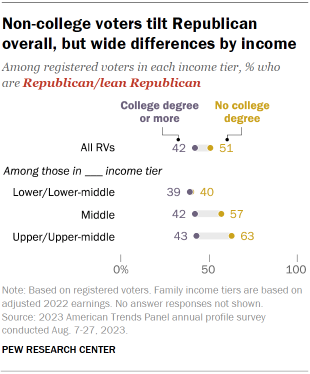
Education and family income: Voters without a college degree differ substantially by income in their party affiliation. Those with middle, upper-middle and upper family incomes tend to align with the GOP. A majority with lower and lower-middle incomes identify as Democrats or lean Democratic. There are no meaningful differences in partisanship among voters with at least a four-year bachelor’s degree; across income categories, majorities of college graduate voters align with the Democratic Party. (Explore this further in Chapter 6 .)
Rural voters move toward the GOP, while the suburbs remain divided: In 2008, when Barack Obama sought his first term as president, voters in rural counties were evenly split in their partisan loyalties. Today, Republicans hold a 25 percentage point advantage among rural residents (60% to 35%). There has been less change among voters in urban counties, who are mostly Democratic by a nearly identical margin (60% to 37%). The suburbs – perennially a political battleground – remain about evenly divided. (Explore this further in Chapter 7 . )
Growing differences among religious groups: Mirroring movement in the population overall, the share of voters who are religiously unaffiliated has grown dramatically over the past 15 years. These voters, who have long aligned with the Democratic Party, have become even more Democratic over time: Today 70% identify as Democrats or lean Democratic. In contrast, Republicans have made gains among several groups of religiously affiliated voters, particularly White Catholics and White evangelical Protestants. White evangelical Protestants now align with the Republican Party by about a 70-point margin (85% to 14%). (Explore this further in Chapter 5 .)
What this report tells us – and what it doesn’t
In most cases, the partisan allegiances of voters do not change a great deal from year to year. Yet as this study shows, the long-term shifts in party identification are substantial and say a great deal about how the country – and its political parties – have changed since the 1990s.

The steadily growing alignment between demographics and partisanship reveals an important aspect of steadily growing partisan polarization. Republicans and Democrats do not just hold different beliefs and opinions about major issues , they are much more different racially, ethnically, geographically and in educational attainment than they used to be.
Yet over this period, there have been only modest shifts in overall partisan identification. Voters remain evenly divided, even as the two parties have grown further apart. The continuing close division in partisan identification among voters is consistent with the relatively narrow margins in the popular votes in most national elections over the past three decades.
Partisan identification provides a broad portrait of voters’ affinities and loyalties. But while it is indicative of voters’ preferences, it does not perfectly predict how people intend to vote in elections, or whether they will vote. In the coming months, Pew Research Center will release reports analyzing voters’ preferences in the presidential election, their engagement with the election and the factors behind candidate support.
Next year, we will release a detailed study of the 2024 election, based on validated voters from the Center’s American Trends Panel. It will examine the demographic composition and vote choices of the 2024 electorate and will provide comparisons to the 2020 and 2016 validated voter studies.
The partisan identification study is based on annual totals from surveys conducted on the Center’s American Trends Panel from 2019 to 2023 and telephone surveys conducted from 1994 to 2018. The survey data was adjusted to account for differences in how the surveys were conducted. For more information, refer to Appendix A .
Previous Pew Research Center analyses of voters’ party identification relied on telephone survey data. This report, for the first time, combines data collected in telephone surveys with data from online surveys conducted on the Center’s nationally representative American Trends Panel.
Directly comparing answers from online and telephone surveys is complex because there are differences in how questions are asked of respondents and in how respondents answer those questions. Together these differences are known as “mode effects.”
As a result of mode effects, it was necessary to adjust telephone trends for leaned party identification in order to allow for direct comparisons over time.
In this report, telephone survey data from 1994 to 2018 is adjusted to align it with online survey responses. In 2014, Pew Research Center randomly assigned respondents to answer a survey by telephone or online. The party identification data from this survey was used to calculate an adjustment for differences between survey mode, which is applied to all telephone survey data in this report.
Please refer to Appendix A for more details.
Facts are more important than ever
In times of uncertainty, good decisions demand good data. Please support our research with a financial contribution.
Report Materials
Table of contents, behind biden’s 2020 victory, a voter data resource: detailed demographic tables about verified voters in 2016, 2018, what the 2020 electorate looks like by party, race and ethnicity, age, education and religion, interactive map: the changing racial and ethnic makeup of the u.s. electorate, in changing u.s. electorate, race and education remain stark dividing lines, most popular.
About Pew Research Center Pew Research Center is a nonpartisan fact tank that informs the public about the issues, attitudes and trends shaping the world. It conducts public opinion polling, demographic research, media content analysis and other empirical social science research. Pew Research Center does not take policy positions. It is a subsidiary of The Pew Charitable Trusts .
How pregnancy may speed up the aging process

The fatigue and pangs of pregnancy have made many women feel older than their years. Now there’s new research that suggests pregnancy may, in fact, accelerate the aging process.
Two new studies of genetic markers in the blood cells of pregnant women suggest that their cells seem to age at an exaggerated clip, adding extra months or even years to a woman’s so-called biological age as her pregnancy progresses.
But one of the studies also suggests this process may reverse itself once a woman gives birth, rewinding time so that some mothers’ cells seemingly end up biologically younger afterward than they’d been during gestation, especially if a mother breastfeeds her baby.
Together, the studies underscore how physically demanding pregnancy is. But they also raise important questions about aging itself and whether it really can be sped up, slowed or reversed by pregnancy.
Aging in pregnancy
The newest of the studies , published today in Proceedings of the National Academy of Sciences, found pregnancy “has a big impact on a woman’s body” and biological age, said Calen P. Ryan, an associate research scientist at the Columbia Aging Center at Columbia University in New York, who led the new research.
In it, scientists used several different biological-age “clocks” and other measures to analyze DNA markers in blood samples. These clocks aren’t timepieces but, instead, algorithms, developed using artificial intelligence programs, that examine the patterns of specialized chemical markers found on the outside of some genes. These markers accumulate and change in response to our age, health and lifestyles, a process known as epigenetics.
The algorithms can use these epigenetic markers to estimate the relative age of cells. This measure, often referred to as biological age, can differ from someone’s chronological age, which just means how long he or she’s been alive.
In the new study, the researchers checked blood samples from 825 young women in the Philippines, all born in the same year. Some had been or were pregnant, and others hadn’t conceived. Analyzing these samples, the epigenetic clocks broadly agreed that the biological age of the young women who’d been or were pregnant tended to be higher than that of the others, by at least several months, even after the researchers controlled for economic disparities and other social and health factors.
Pregnancy as a stress test
Similarly, the other new study, published in March in Cell Metabolism , used several different epigenetic clocks to estimate the changing internal age of pregnant women at several points during their pregnancies.
“We were very interested in looking at the impacts of pregnancy as a naturally occurring stress test,” said Kieran J. O’Donnell, an assistant professor at the Yale Child Study Center and Yale School of Medicine, who oversaw one of the new studies.
Get Well+Being tips straight to your inbox

With blood samples from 119 pregnant American women and five different clocks, the researchers tracked the epigenetic changes related to the women’s biological age, starting early in gestation and ending three months after they’d given birth.
The clocks again agreed that pregnancy seemed to be aging the incipient moms as they approached full term, making their blood cells’ DNA appear to be as much as two years older than it had been earlier in the pregnancy.
More encouraging, though, O’Donnell said, is that this aging seemed to reverse for most of the women within three months after birth. In general, their patterns of DNA markers soon reverted to an earlier, more-youthful state, and for some new moms who’d breastfed exclusively in the first three months postpartum, overshot the mark, leaving them apparently “younger” biologically than before, by as much as eight years, the study’s authors wrote, “indicating a pronounced reversal of biological aging.”
Disagreement about aging
But some researchers who study aging, longevity and epigenetics are skeptical of the studies’ findings and conclusions. “It seems unlikely to me that pregnancy induces a whole-body acceleration of biological aging which is then reversed soon after pregnancy,” said Matt Kaeberlein, a longtime longevity researcher who serves as CEO of Optispan, a company that promotes longevity and produces the “Optispan” podcast.
Charles Brenner, who studies metabolism, cancer and aging at the Beckman Research Institute of the City of Hope National Medical Center in California was blunter in an email. “100%, it’s a misuse of aging biomarkers,” he wrote.
Both scientists, as well as others who’ve discussed the studies online, speculate that the epigenetic shifts seen during pregnancy probably reflect the profound physiological demands of carrying a child. They’re “a transient response to the stress of pregnancy, particularly in the immune system,” Kaeberlein said.
What they aren’t is evidence that pregnant women suddenly get older and then younger, these researchers say, or experience lasting effects that could directly shorten or lengthen their life spans.
But the cellular changes being picked up and analyzed by the epigenetic clocks might someday be useful health indicators. If a pregnant woman’s epigenetic markers don’t soon bounce back once she’s no longer pregnant, she and her doctor might want to closely monitor her blood pressure, blood sugar and other standard measures of health, not because she suddenly seems older after becoming pregnant, but because, Ryan said, “pregnancy is such a big deal, physically.”
Do you have a fitness question? Email [email protected] and we may answer your question in a future column.
Read more from Well+Being
Well+Being shares news and advice for living well every day. Sign up for our newsletter to get tips directly in your inbox.
Are you taking your meds wrong ? Many patients make these common mistakes.
Centenarians give their advice about everything.
The wall sit is a simple exercise that can lower your blood pressure.
Tart cherries — more specifically, tart cherry juice — may help with inflammation and pain.
Do you self-sabotage ? Here’s how to stop.

Thank you for visiting nature.com. You are using a browser version with limited support for CSS. To obtain the best experience, we recommend you use a more up to date browser (or turn off compatibility mode in Internet Explorer). In the meantime, to ensure continued support, we are displaying the site without styles and JavaScript.
- View all journals
Spinal cord injury articles from across Nature Portfolio
A spinal cord injury consists of damage to the spinal cord that results from external trauma including accidents, falls and sports-related injuries, rather than a degenerative disease. The effects of a spinal cord injury widely vary from no effect, to pain, or to complete loss of spinal cord function.
Latest Research and Reviews

Intrathecal delivery of adipose-derived mesenchymal stem cells in traumatic spinal cord injury: Phase I trial
In the CELLTOP Phase I trial, stem cells were harvested from patients with spinal cord injury and injected into their central nervous system after processing. The procedure was safe, with no reported serious adverse events during the 2-year follow-up period.
- Mohamad Bydon
- Allan B. Dietz
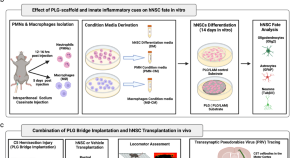
Multichannel bridges and NSC synergize to enhance axon regeneration, myelination, synaptic reconnection, and recovery after SCI
- Usha Nekanti
- Pooja S. Sakthivel
- Aileen J. Anderson
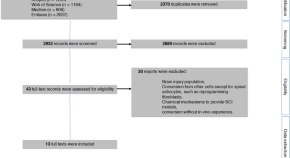
Reprogramming of astrocytes to neuronal-like cells in spinal cord injury: a systematic review
- Seyed Danial Alizadeh
- Mohammad-Rasoul Jalalifar
- Vafa Rahimi-Movaghar
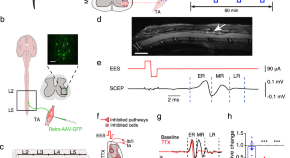
Dual electrical stimulation at spinal-muscular interface reconstructs spinal sensorimotor circuits after spinal cord injury
Electrical signals with characteristic parameters for reconstructing neural circuits remain incompletely understood, limiting the therapeutic potential of electrical neuromodulation techniques. Here, the authors demonstrate that dual electrical stimulation at 10–20 Hz rebuilds the spinal sensorimotor neural circuit after spinal cord injury, indicating the characteristic signals of circuit remodeling.
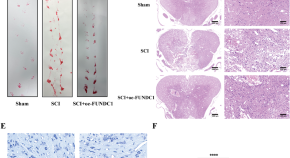
FUNDC1-induced mitophagy protects spinal cord neurons against ischemic injury
- Linquan Zhou
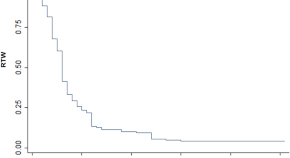
Return to work after traumatic spinal fractures and spinal cord injuries: a retrospective cohort study
- Fateme Keihanian
- Enayatollah Homaie Rad
- Naema Khodadadi-Hassankiadeh
News and Comment
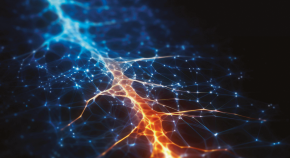
Regrowth and recovery in mice with spinal cord injury
Directed axonal regeneration has restored walking function in mice with complete spinal cord injury.
Personalized EES for SCI
- Elisa Floriddia
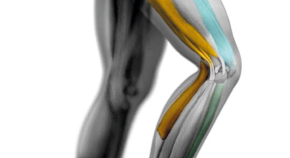
Breakthrough technology restores function after complete paralysis

Mend the gap
Spiny mice ( Acomys cahirinus ) are revealed to recover motor co-ordination following complete spinal cord transection, owing to regrowth of axonal motor pathways across the lesion site.
Repairing nerve damage
Regenerative neurogenesis after spinal cord injury in zebrafish involves TNF signalling between lesion-activated macrophages and spinal progenitor cells.
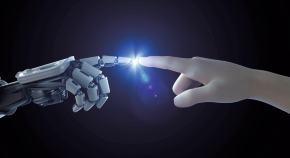
Bidirectional brain–computer interface aids robotic arm control
- Heather Wood
Quick links
- Explore articles by subject
- Guide to authors
- Editorial policies
Skip to Content
A new look at western water
The Mountain Hydrology Group will be developing a new snowpack data set to inform water supply management in the western United States, thanks to grant funding from the U.S. Bureau of Reclamation.
Researchers in the Mountain Hydrology Group currently produce near-real-time estimates of snow water equivalent, or the amount of water contained in fallen snow, for mountainous areas in California, Colorado, New Mexico, Utah, and Wyoming. Reports and data are released to water managers and forecasters and are also available to the public.
With the new grant of $1 million over the next three years, the group will be able to expand its estimates to all 17 western states, notably adding mountainous areas in Idaho, Montana, Oregon, and Washington and large mountain ranges such as the Cascades and northern Rocky Mountains.
The grant will support Noah Molotch (lead PI), Leanne Lestak, Emma Tyrrell, and Karl Rittger in analyzing snow data and producing biweekly snow water supply reports to support decision making by federal, state, and local water management entities responsible for managing water supplies in the western United States.
The Bureau of Reclamation awarded funds to 15 different projects as part of its Snow Water Supply Forecasting Program to improve water supply forecasting.
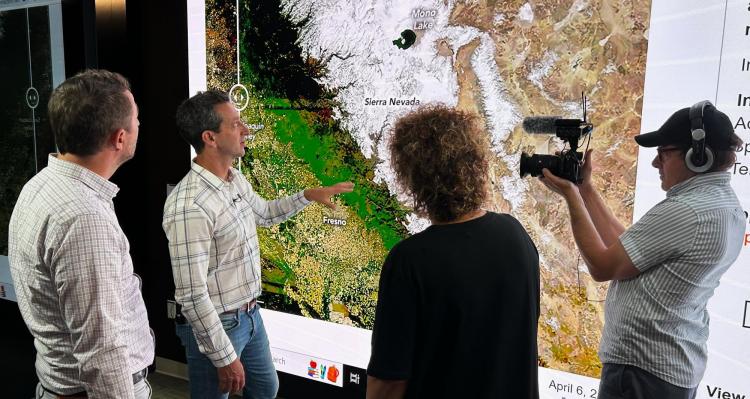
Noah Molotch shows information about the snow-water equivalent for California during a television interview at NASA Jet Propulsion Laboratory. Photo copyright by and courtesy of Pier Gagné, Radio-Canada.

Maps show various aspects of snow-water equivalent for California's Sierra Nevada. The maps are part of the April 1, 2024 report from the Mountain Hydrology Group.
Related Articles

LogOn: Satellites, lasers help estimate snowpack in drought-stricken regions (VOA)

Californie, quand l'impensable se produit (Radio-Canada)

Scientists take flight to map California’s vast snowpack and measure flooding threats (L.A. Times)
- Labs, groups, & programs
Labs & Groups
- Advanced Laser Technology for Atmospheric Research (Fried)
- Amino Acid Geochronology (Miller)
- AMS Radiocarbon Preparation & Research (Lehman)
- Coastal Oceanography Modeling (Moriarty)
- Core Processing & Sedimentology (Roth & Anderson)
- Cryosphere and Surface Processes (Overeem et al.)
- Diatoms (Spaulding)
- Ecohydrology (Barnard)
- Hydroecology Science & Engineering (Gooseff) ↪︎
- ICP-MS Trace Metals (Marchitto)
- Micropaleontology (Jennings)
- Mountain Hydrology (Molotch, Musselman, & Rittger)
- Mountain Limnology Lab (Oleksy) ↪︎
- Ocean Biogeochemistry (Lovenduski)
- Organic Geochemistry (Sepúlveda)
- Organic Matter Spectroscopy (McKnight)
- Polar & Paleoclimate Modeling (Jahn)
- Stable Isotope Lab
- Suding Lab - plant community ecology ↪︎
- Taylor Lab - evolutionary biology & genetics of birds ↪︎
- Center for the Geochemical Analysis of the Global Environment (GAGE)
- Community Surface Dynamics Modeling System (CSDMS)
- Consortium for Capacity Building (CCB)
- DFO - Flood Observatory
- Dynamic Water critical zone project
- McMurdo Dry Valleys Long-Term Ecological Research (MCM LTER)
- Mountain Research Station (MRS)
- Niwot Ridge Long-Term Ecological Research (NWT LTER)
- Labs & groups
- AAAR journal ↪
- Theses and dissertations
- Occasional Papers
- Faculty Fellows
- Faculty Research Scientists
- Faculty Fellows Emeriti
- Research Staff
- Admin Staff
- DEI summer scholarships
- Our actions
- Addressing problematic behavior
Meet an INSTAAR Art+Science showcase
- Research news
- People spotlights
- Diversity news
- Community news
- Diversity events
- Community events
About INSTAAR
- Visit INSTAAR
Prospective students
- Grad application assistance (GAAP)
- Undergrad opportunities
Resources for INSTAARs
Support instaar.

Find Info For
- Current Students
- Prospective Students
- Research and Partnerships
- Entrepreneurship and Commercialization
Quick Links
- Health and Life Sciences
- Info Security and AI
- Transformative Education
- Purdue Today
- Purdue Global
- Purdue in the News
April 3, 2024
SK hynix announces semiconductor advanced packaging investment in Purdue Research Park
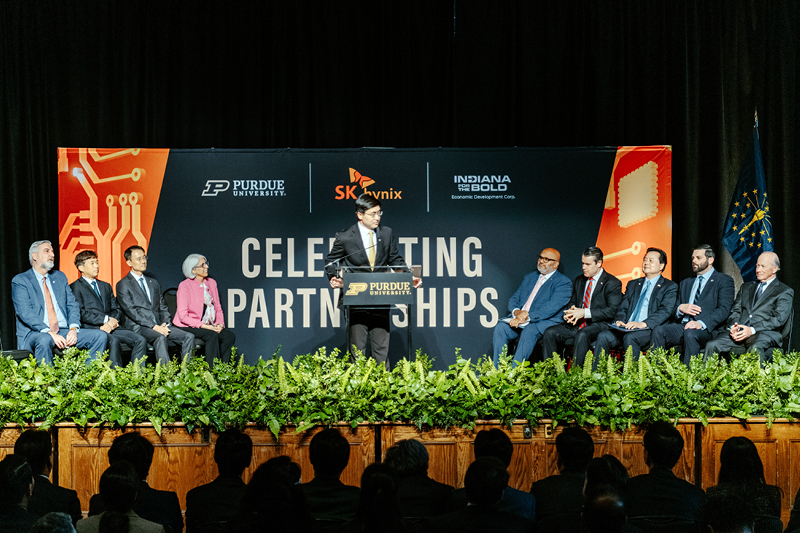
SK hynix announced Wednesday (April 3) semiconductor advanced packaging investment in Purdue Research Park. From left to right: Indiana Gov. Eric Holcomb; Kwak Noh-jung, SK hynix president and CEO; Woojin Choi, SK hynix executive vice president; Arati Prabhakar, director, White House Office of Science and Technology Policy, and assistant to the president for science and technology; Mung Chiang, Purdue University president (speaking); Arun Venkataraman, U.S. Department of Commerce assistant secretary; U.S. Sen. Todd Young; Hyundong Cho, ambassador of the Republic of Korea to the United States; David Rosenberg, Indiana secretary of commerce; Mitch Daniels, Purdue Research Foundation chairman. (Purdue University/Kelsey Lefever)
The company's facility for AI memory chips marks the largest single economic development in the history of the state
WEST LAFAYETTE, Ind. — SK hynix Inc. announced Wednesday (April 3) that it plans to invest close to $4 billion to build an advanced packaging fabrication and R&D facility for AI products in the Purdue Research Park. The development of a critical link in the U.S. semiconductor supply chain in West Lafayette marks a giant leap forward in the industry and the state.
“We are excited to build a state-of-the-art advanced packaging facility in Indiana,” said SK hynix CEO Kwak Noh-Jung. “We believe this project will lay the foundation for a new Silicon Heartland, a semiconductor ecosystem centered in the Midwest Triangle. This facility will create local, high-paying jobs and produce AI memory chips with unmatched capabilities, so that America can onshore more of its critical chip supply chain. We are grateful for the support of Gov. Holcomb and the state of Indiana, of President Chiang at Purdue University, and of the broader community involved, and we look forward to expanding our partnership in the long run.”
SK hynix joins Bayer, imec, MediaTek, Rolls-Royce, Saab and many more national and international companies bringing innovation to America's heartland. The new facility — home to an advanced semiconductor packaging production line that will mass-produce next-generation high-bandwidth memory, or HBM, chips, the critical component of graphic processing units that train AI systems such as ChatGPT — is expected to provide more than a thousand new employment opportunities in the Greater Lafayette community. The company plans to begin mass production in the second half of 2028.
The project marks SK hynix’s intention for long-term investment and partnership in Greater Lafayette. The company’s decision-making framework prioritizes both profit and social responsibility while promoting ethical actions and accountability. From infrastructure developments that make accessing amenities easier to community empowerment projects such as skill development and mentorship, the SK hynix advanced packaging fabrication marks a new era of collaborative growth.
“Indiana is a global leader in innovating and producing the products that will power our future economy, and today’s news is proof positive of that fact,” said Indiana Gov. Eric Holcomb. “I’m so proud to officially welcome SK hynix to Indiana, and we’re confident this new partnership will enhance the Lafayette-West Lafayette region, Purdue University and the state of Indiana for the long term. This new semiconductor innovation and packaging plant not only reaffirms the state’s role in the hard-tech sector, but is also another tremendous step forward in advancing U.S. innovation and national security, putting Hoosiers at the forefront of national and global advancements.”
Investment in the Midwest and Indiana was spurred by Purdue’s excellence in discovery and innovation and its track record of exceptional R&D and talent development through collaboration. Partnerships among Purdue, the corporate sector, and the state and federal government are essential to advancing the U.S. semiconductor industry and establishing the region as the Silicon Heartland.
“SK hynix is the global pioneer and dominant market leader in memory chips for AI,” Purdue President Mung Chiang said. “This transformational investment reflects our state and university’s tremendous strength in semiconductors, hardware AI and development of the Hard-Tech Corridor. It is also a monumental moment for completing the supply chain of the digital economy in our country through the advanced packaging of chips. Located at Purdue Research Park, the largest facility of its kind at a U.S. university will grow and succeed through innovation.”
In 1990 the U.S. was producing nearly 40% of the world’s semiconductors. However, as manufacturing moved to Southeast Asia and China, the U.S. global output of semiconductor manufacturing has fallen to closer to 12%.
“SK hynix will soon be a household name in Indiana,” said U.S. Sen. Todd Young. “This incredible investment demonstrates their confidence in Hoosier workers, and I’m excited to welcome them to our state. The CHIPS and Science Act opened a door that Indiana has been able to sprint through, and companies like SK hynix are helping to build our high-tech future.”
To aid in bringing semiconductor manufacturing closer to home and shoring up global supply chains, the U.S. Congress introduced the Creating Helpful Incentives to Produce Semiconductors for America Act, or CHIPS and Science Act, on June 11, 2020. Signed by President Joe Biden on Aug. 9, 2022, it funds holistic development of the semiconductor industry to the tune of $280 billion. It supports the nation's research and development, manufacturing, and supply chain security of semiconductors.
“When President Biden signed the bipartisan CHIPS and Science Act, he put a stake in the ground and sent a signal to the world that the United States cares about semiconductor manufacturing,” said Arati Prabhakar, President Biden’s chief science and technology advisor and director of the White House Office of Science and Technology Policy. “Today’s announcement will strengthen the economy and national security, and it will create good jobs that support families. This is how we do big things in America.”
Purdue Research Park, one of the largest university-affiliated incubation complexes in the country, unites discovery and delivery with easy access to Purdue faculty experts in the semiconductor field, highly sought-after graduates prepared to work in the industry, and vast Purdue research resources. The park also offers convenient accessibility for workforce and semitruck traffic, with access to I-65 just minutes away.
This historic announcement is the next step in Purdue University’s persistent pursuit of semiconductor excellence as part of the Purdue Computes initiative. Recent announcements include these
- Purdue University Comprehensive Semiconductors and Microelectronics Program
- A strategic partnership with Dassault Systèmes to improve, accelerate and transform semiconductor workforce development
- European technology leader imec opens innovation hub at Purdue
- The nation’s first comprehensive Semiconductor Degrees Program
- Purdue continues to create unique lab-to-fab ecosystem for the state and country
- Green2Gold, a collaboration between Ivy Tech Community College and Purdue University to grow Indiana’s engineering workforce
What they’re saying
- “This decision by a world-renowned, best-in-class company represents a dramatic fulfillment of Purdue’s duty to serve the state as not only its premier academic institution but also its No. 1 economic asset. It’s also a gratifying validation of our Discovery Park District initiative to bring new opportunities to our students, faculty and Greater Lafayette neighbors. Today marks the Purdue ecosystem’s latest and greatest, but assuredly not its last, contribution to a more prosperous Indiana and a stronger America.” — Mitch Daniels, chairman of the board, Purdue Research Foundation
- “On behalf of my fellow trustees, we are pleased to welcome SK hynix Inc. to the Purdue Research Park. Their arrival will significantly strengthen Purdue University’s dual commitments to educating the next generation of workforce leaders in semiconductors and supporting the national security of our nation.” — Michael Berghoff, chair, Purdue Board of Trustees
- “The impact of SK hynix is more than the creation of high-paying careers for Hoosiers. Undergraduates will have opportunities for internships, co-op and full-time employment when they graduate. Graduate students and faculty will work closely with SK hynix researchers, not only on basic research, but also to accelerate the transition of research into pilot production and manufacturing. This is just the beginning. As other companies see what’s happening here in the heart of the heartland, they’ll come too, and a significant new cluster of semiconductor manufacturing and research will emerge.” — Mark Lundstrom, chief semiconductor officer, Purdue University
- “West Lafayette is thrilled to join our national efforts to bring the semiconductor industry to the United States through President Biden’s CHIPS and Science Act. This partnership will leverage Purdue University’s science and research expertise with SK hynix’s innovation in semiconductor technology. The impact on West Lafayette will enable us to continue to provide the high level of service our community expects and to increase our quality-of-life amenities for the region so we can attract and retain the excellent graduates of Purdue University. In addition, SK hynix’s global dedication to net zero carbon emissions by 2050, water process reduction and recycling, and zero-waste-to-landfill programs aligns with our community’s commitment to environmental stewardship. We are grateful for SK hynix’s investment and commitment to West Lafayette and for our partners Purdue University, Purdue Research Foundation, the city of Lafayette, Tippecanoe County and the Greater Lafayette region.” — Erin Easter, mayor of West Lafayette
- “The pandemic disruption has shown the reliance on semiconductors, with production concentrated in limited regions around the world. Greater Lafayette has worked continuously and cooperatively for years to position ourselves for an opportunity of this magnitude, and we look forward to the long-term economic impact this will have on our communities. The collaborative efforts between cities and county governments, Purdue University, the state of Indiana and Sen. Todd Young’s office is a testament to these efforts. Our joint investments in infrastructure, innovation, along with quality-of-life initiatives, have contributed to this venture becoming a reality. We look forward to working with and welcoming SK hynix to Greater Lafayette!” — Tony Roswarski, mayor of Lafayette
- “Ivy Tech, as Indiana’s largest postsecondary institution, is focused on building Indiana talent pipelines aligned to employers and emerging industries which strengthen Indiana’s economy. The microelectronics industry will play a key role in Indiana’s success, which is why we are pleased to work with SK hynix and Purdue to provide training, credentials and degrees designed for the semiconductor industry. SK hynix’s commitment to Indiana reinforces that we all win when we address complex issues through strong partnerships." — Sue Ellspermann, president, Ivy Tech Community College
- “Semiconductors and microelectronics are at the forefront of focus for Purdue Research Foundation. I am pleased to welcome SK hynix to Indiana and start the hard work of ensuring this is the best business decision that SK hynix has ever made.” — Brian Edelman, president, Purdue Research Foundation
- “The Alliances team is thrilled to welcome SK hynix to the Purdue ecosystem, and we look forward to empowering them to thrive here in Indiana with all the immense assets Purdue and Greater Lafayette offer. We look forward to forging a strong relationship with mutual value for SK hynix, Purdue Research Foundation and the broader Greater Lafayette community for many years to come.” — Gregory Deason, senior vice president of alliances and placemaking, Purdue Research Foundation
- “During my time at Purdue Research Foundation, we have consistently been successful in assisting our partners like Saab in developing complex builds well ahead of schedule and within budget. I look forward to building on our excellent track record with SK hynix to help them in creating a state-of-the-art facility which best meets their unique needs.” — Richard Michal, senior vice president of capital projects and facilities, Purdue Research Foundation
About SK hynix Inc.
SK hynix Inc., headquartered in Korea, is the world’s top-tier semiconductor supplier offering Dynamic Random Access Memory chips (“DRAM”), flash memory chips (“NAND flash”) and CMOS Image Sensors (“CIS”) for a wide range of distinguished customers globally. The Company’s shares are traded on the Korea Exchange, and the Global Depository shares are listed on the Luxembourg Stock Exchange. Further information about SK hynix is available at www.skhynix.com , news.skhynix.com .
About Purdue Research Foundation
Purdue Research Foundation is a private, nonprofit foundation created to advance the mission of Purdue University. Established in 1930, the foundation accepts gifts, administers trusts, funds scholarships and grants, acquires and sells property, protects and licenses Purdue's intellectual property, and supports creating Purdue-connected startups on behalf of Purdue. The foundation operates Purdue Innovates, which includes the Office of Technology Commercialization, Incubator and Ventures. The foundation manages the Purdue Research Park, Discovery Park District, Purdue Technology Centers and Purdue for Life Foundation.
For more information on licensing a Purdue innovation, contact the Office of Technology Commercialization at [email protected] . For more information about involvement and investment opportunities in startups based on a Purdue innovation, contact Purdue Innovates at [email protected] .
About Purdue University
Purdue University is a public research institution demonstrating excellence at scale. Ranked among top 10 public universities and with two colleges in the top four in the United States, Purdue discovers and disseminates knowledge with a quality and at a scale second to none. More than 105,000 students study at Purdue across modalities and locations, including nearly 50,000 in person on the West Lafayette campus. Committed to affordability and accessibility, Purdue’s main campus has frozen tuition 13 years in a row. See how Purdue never stops in the persistent pursuit of the next giant leap — including its first comprehensive urban campus in Indianapolis, the new Mitchell E. Daniels, Jr. School of Business, and Purdue Computes — at https://www.purdue.edu/president/strategic-initiatives .
Media contact:
Tim Doty, [email protected]
Note to journalists: Photo, b-roll and sound bites from this announcement will be available for media use on Google Drive .
Research News
Communication.
- OneCampus Portal
- Brightspace
- BoilerConnect
- Faculty and Staff
- Human Resources
- Colleges and Schools
Info for Staff
- Purdue Moves
- Board of Trustees
- University Senate
- Center for Healthy Living
- Information Technology
- Ethics & Compliance
- Campus Disruptions
Purdue University, 610 Purdue Mall, West Lafayette, IN 47907, (765) 494-4600
© 2015-24 Purdue University | An equal access/equal opportunity university | Copyright Complaints | Maintained by Office of Strategic Communications
Trouble with this page? Disability-related accessibility issue? Please contact News Service at [email protected] .

IMAGES
VIDEO
COMMENTS
As many as 500,000 people around the world each year experience a spinal cord injury.Depending on the severity of the injury, it can cause paralysis and affect a person's ability to move and ...
Also, new science to address spinal cord injury could have impact on strategies for neurodegenerative diseases and stroke." 'Dancing molecules' hit moving targets. The secret behind Stupp's new breakthrough therapeutic is tuning the motion of molecules, so they can find and properly engage constantly moving cellular receptors.
Now, new research by Northwestern University scientists has resulted in a game-changing innovation: an injection that uses " dancing molecules" to repair spinal tissue and reverse paralysis. The treatment has already been shown to work in mice. Paralyzed mice regained their ability to walk four weeks after an injection of the new treatment.
Feinstein Institutes researchers first to use double neural bypass to restore feeling, movement in man living with quadriplegia. July 28th, 2023 Matthew Libassi. ... The Feinstein Institutes—the research institutes of Northwell Health, New York's largest health care provider—is home to 50 research labs, 3,000 clinical research studies and ...
For the first time researchers restore feeling and lasting movement in man living with quadriplegia. Keith Thomas, who lives with paralysis, poses with the research team at Northwell Health's ...
According to the National Spinal Cord Injury Statistics Center (NSCISC), the annual incidence of SCI is approximately 54 cases per 1 million people in the US, or approximately 17,700 new SCI cases per year. SCI can have a sudden and sometimes catastrophic impact on quality of life, resulting in severe motor, sensory, and autonomic dysfunction.
Dr. Gorman said medications used for diabetic neuropathy—such as duloxetine, pregabalin, and gabapentin—also are often used in patients with spinal cord injuries because many develop neuropathic pain. In animal models, many drugs over the past 25 years have been shown to act on neurotransmitters and other receptors to activate neural ...
Intravenous injection of bone marrow derived stem cells (MSCs) in patients with spinal cord injuries led to significant improvement in motor functions, researchers from Yale University and Japan report Feb. 18 in the Journal of Clinical Neurology and Neurosurgery. For more than half of the patients, substantial improvements in key functions ...
Spinal cord injury (SCI) remains a severe condition with an extremely high disability rate. The challenges of SCI repair include its complex pathological mechanisms and the difficulties of neural ...
Credit: EPFL / .Neurorestore. When the spinal cords of mice and humans are partially damaged, the initial paralysis is followed by the extensive, spontaneous recovery of motor function. However ...
The clinical trial conducted at medical centers around the country offers some hope. It is a follow-up to successful animal trials. The trial recruited 16 people ages 16-70 with severe injuries in the thoracic section of their spinal column. The thoracic section begins at the neck's base, extends to the bottom of the rib cage, and includes 12 ...
Innovative nanogels developed by researchers have shown effectiveness in targeting glial cells for the treatment of spinal cord injuries, offering a new avenue for therapeutic intervention. In a study published in Advanced Materials, researchers Pietro Veglianese, Valeria Veneruso, and Emilia Petillo from Istituto di Ricerche Farmacologiche ...
A unique material developed at the University of Limerick in Ireland has demonstrated considerable potential in the treatment of spinal cord injuries. Exciting new research conducted at the Bernal Institute at the University of Limerick (UL) and published in the journal Biomaterials Research, has made significant strides in the area of spinal ...
New research has demonstrated the safety and tolerability of a new drug treatment designed as a therapeutic intervention for spinal cord injury (SCI). Share: Facebook Twitter Pinterest LinkedIN Email
The research team published these findings Jan. 5 in the journal IEEE Transactions on Neural Systems and Rehabilitation Engineering. "We use our hands for everything — eating, brushing our teeth, buttoning a shirt. Spinal cord injury patients rate regaining hand function as the absolute first priority for treatment.
The award recognizes his innovative research into spinal cord injuries. Kim, who is also a professor in the Department of Neurological Surgery was selected for his research paper titled, "Acute Implantation of a Bioresorbable Polymer Scaffold in Patients With Complete Thoracic Spinal Cord Injury: 24-Month Follow-up From the INSPIRE Study."
Graphical Abstract. Credit: Cell Reports Medicine (2023). DOI: 10.1016/j.xcrm.2023.100946
The foundation, named in honor of Will Reeve's late father, was not involved in the funding of Bydon's research. Bydon's research at the Mayo Clinic is a Phase 1 study that began in 2018.
Quadriplegia News and Research RSS. ... Independence in mobility is the single most important factor affecting quality of life in patients with traumatic spinal cord injury, reports a study in the ...
The CHIPS for America Research and Development (R&D) Program and Natcast, the operator of the CHIPS for America National Semiconductor Technology Center (NSTC), will host a webinar to provide an overview of the NSTC's vision and mission, an update on 2024 priorities for the NSTC, the standing up of Natcast, and the first NSTC research opportunities.
About Pew Research Center Pew Research Center is a nonpartisan fact tank that informs the public about the issues, attitudes and trends shaping the world. It conducts public opinion polling, demographic research, media content analysis and other empirical social science research. Pew Research Center does not take policy positions.
Charles Brenner, who studies metabolism, cancer and aging at the Beckman Research Institute of the City of Hope National Medical Center in California was blunter in an email. "100%, it's a ...
A spinal cord injury consists of damage to the spinal cord that results from external trauma including accidents, falls and sports-related injuries, rather than a degenerative disease. The effects ...
Walking tour around Moscow-City.Thanks for watching!MY GEAR THAT I USEMinimalist Handheld SetupiPhone 11 128GB https://amzn.to/3zfqbboMic for Street https://...
The Mountain Hydrology Group will be developing a new snowpack data set to inform water supply management in the western United States, thanks to grant funding from the U.S. Bureau of Reclamation. ... Institute of Arctic and Alpine Research University of Colorado Campus Box 450
In his new book, "Why We Die: The New Science of Aging and the Quest for Immortality," Nobel Prize-winning molecular biologist Venki Ramakrishnan sifts through past and cutting-edge research ...
SK hynix Inc. announced Wednesday (April 3) that it plans to invest close to $4 billion to build an advanced packaging fabrication and RD facility for AI products in the Purdue Research Park. The development of a critical link in the U.S. semiconductor supply chain in West Lafayette marks a giant leap forward in the industry and the state.
St. Jude Children's Research Hospital. St. Jude Children's Research Hospital is leading the way the world understands, treats and cures childhood cancer, sickle cell disease, and other life-threatening disorders. It is the only National Cancer Institute-designated Comprehensive Cancer Center devoted solely to children. Treatments developed at St. Jude have helped push the overall childhood ...
research that informs the development of sustainable solutions to health disparities. o SUNY College of Optometry will use their funds for competitive start-up packages for new researchers in the field of genetics and molecular biology of retinal and eye disease. • At least 7 campuses will purchase new and specialized technology and equipment ...
A week and a half ago, self-isolation, which lasted for the last two months, finally stopped and people can again move around Russia without e-passes. Moscow...